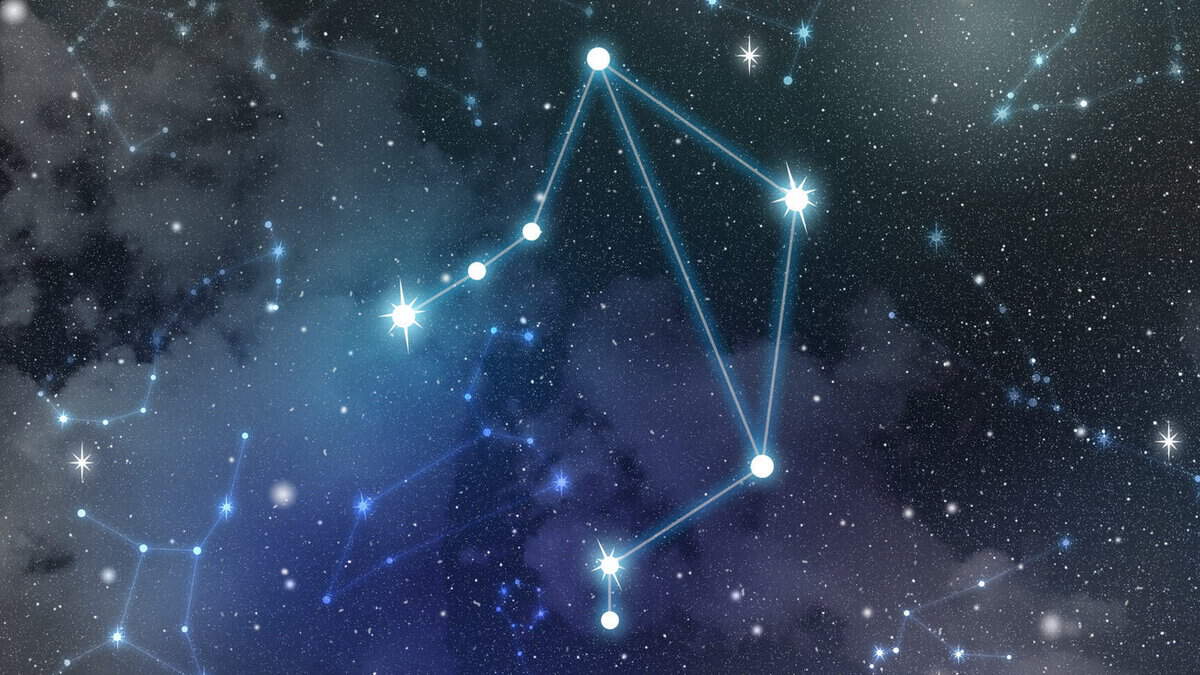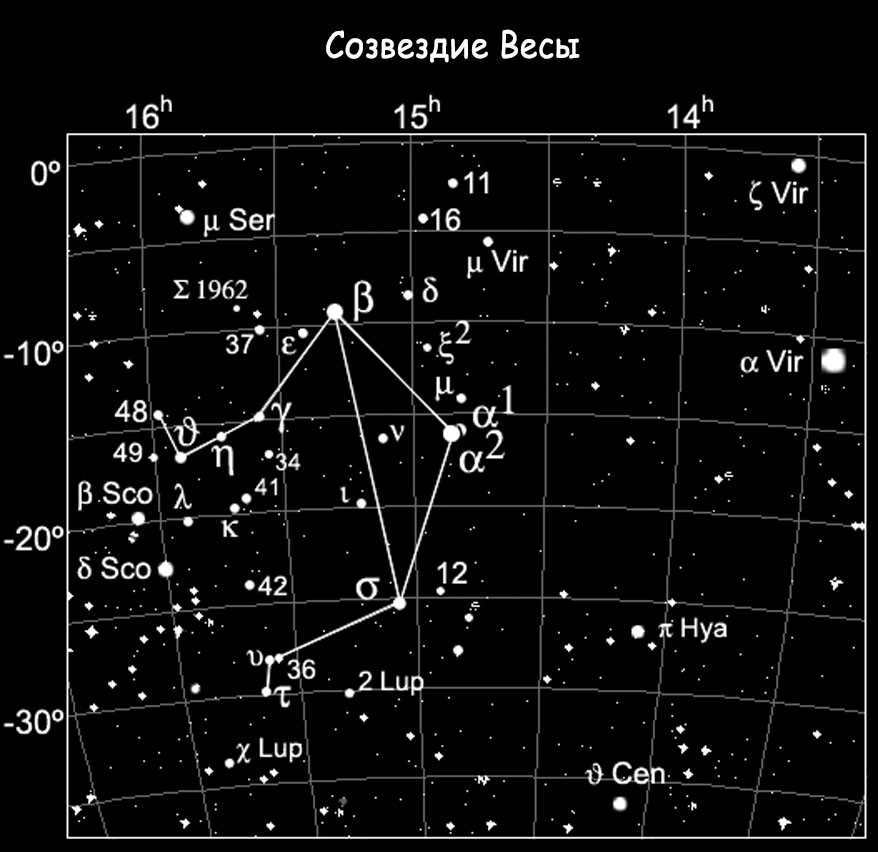
Since ancient times, humans have been aware of the constellation Libra. It is quite remarkable that out of all the constellations in the Zodiac, Libra is the only one that does not bear the name of any living creature.
One of the most ancient denizens of the heavens
As you may be aware, this celestial body is positioned between the constellations known as Scorpio and Virgo. Despite the absence of any stars of significant brightness among the 83 stars within this constellation, it is relatively simple to locate in the night sky. In fact, it is undeniably one of the most prominent features in the nocturnal firmament.
Libra is home to some of the most brilliant stars in the night sky, with a stellar magnitude of 4. To locate this constellation, observers must carefully scan the heavens and identify a distinct rhomboid shape formed by its four brightest stars. Libra shares celestial borders with its neighboring constellations, Serpens, Ophiuchus, and Lupus, also known as the Serpent, the Snake, and the Wolf, respectively. Observers can easily spot Libra in the night sky from April to May. The Sun appears to be within the boundaries of Libra from October 31st to November 22nd, making this the ideal time to observe this constellation. In the southern and central regions of Russia, Libra can be observed in its entirety.
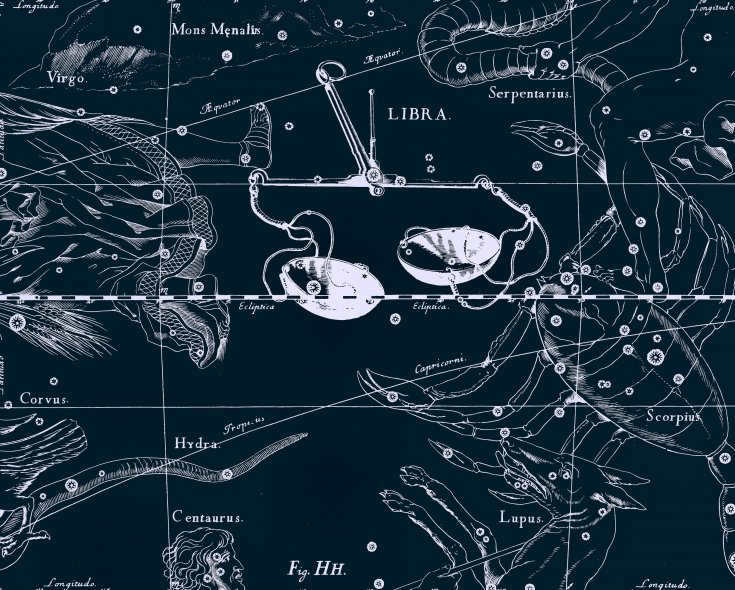
The constellation Libra, depicted in a drawing by Jan Hevelius from his atlas of constellations, has an interesting history. Many thousands of years ago, the stars that make up Libra were actually part of the Scorpio constellation. However, in the second century BC, Libra was established as its own separate constellation. This can be seen in earlier writings by Aratus of Soli, predating the official recognition of Libra. In the first century AD, the poet Virgil even proposed replacing the scales of Libra with a new constellation dedicated to Emperor Augustus, thereby reducing Scorpio’s size. Despite these proposals, Libra has remained as its own distinct constellation throughout history.
When the constellation of Libra was established, it was often referred to as “Pincers”. This was an attempt to associate it with Scorpio. During this time, the stars in this group were sometimes represented as an asterism, and other times as a separate constellation. In Ptolemy’s work, for example, it is listed as a constellation, although it is called “Pinches”. It is interesting to note that during this period, Libra was also known as “Pinches” in the zodiac. However, in the first century B.C., the name Libra became widely accepted. As mentioned before, this zodiacal constellation is unique in the sky, possibly because it was formed relatively late.
The unique arrangement of stars within the constellation being examined
After discussing the claws of the constellation, it is now appropriate to shift our focus to the most notable stars within Libra. We will begin with Libra’s alpha star, also known as Zuben Elgenubi in Arabic. As you may have deduced, this name translates to “southern claw”. In the Latin version, the star’s name incorporates the word “southern” as well, but it refers to a bowl and is pronounced as Ciffa Australis.
Libra Alpha
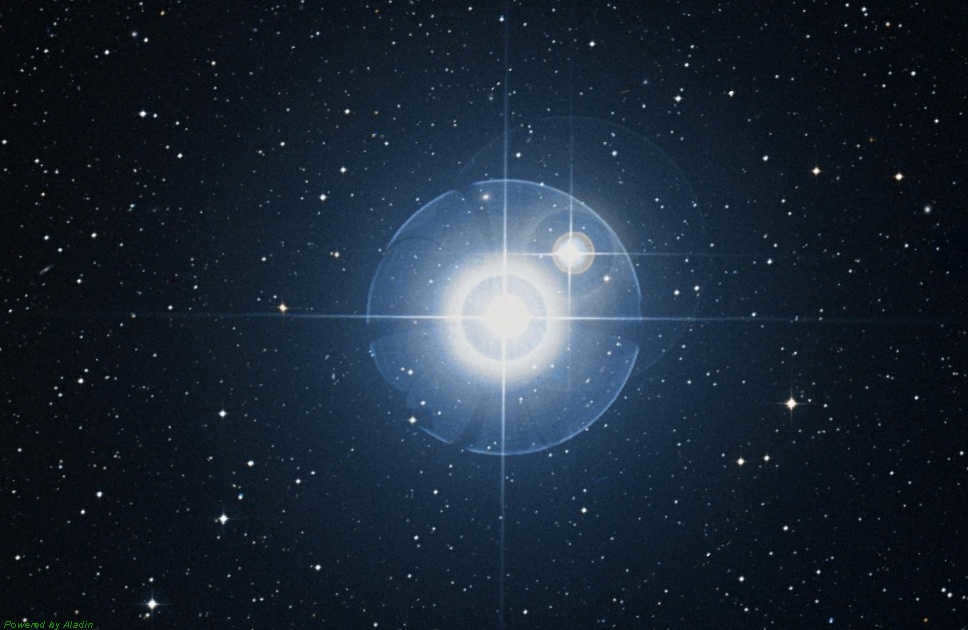
Alpha Libra, the second brightest star in the constellation, is easily visible to the naked eye. However, when observed with small binoculars, it becomes apparent that this star is actually a multiple star system. The primary star, a hot blue luminary with a magnitude of 2.75m, is accompanied by a yellowish star with a stellar magnitude of 5.15m. Despite their similar proper motions, these two stars are separated by a distance of 5 minutes of arc, leading astronomers to question their physical connection.
When we measure the distance between the two components of the system in astronomical units, it amounts to a staggering 5.5 thousand. This means that the stars take a whopping two hundred thousand years to complete one rotation around each other. What’s even more fascinating is that the brighter component of the system is also a double star, but they are so close together that they cannot be distinguished by the naked eye. It’s worth noting that Alpha Libra is located very close to the celestial ecliptic, which means that we have the opportunity to witness the star being covered by planets or the Moon. In the year 2052, we will have the chance to see the star Zuben Elgenub being covered by the planet Mercury.
The other “pincer” of Scorpius in the mentioned constellation
Beta Libra is the ancient designation for the northern pincer of Scorpius in the specific constellation. Zuben el Shemali is its Arabic translation. However, the star is also known as Ciffa Borealis in Latin, signifying the “northern bowl” and aligning more closely with the constellation’s name.
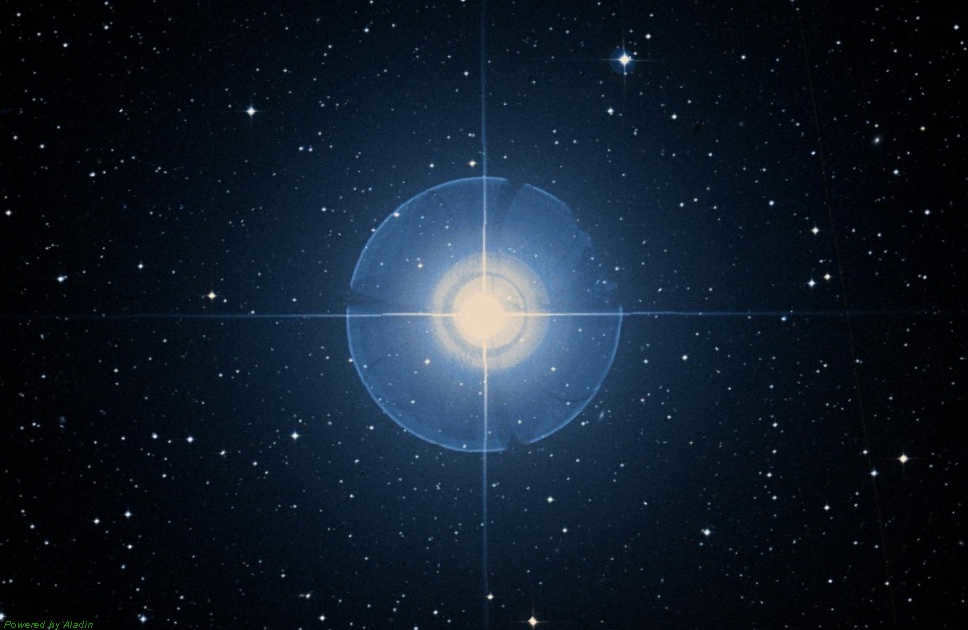
Beta Libra is a star that shines with a blue-white hue. It belongs to the main sequence of stars and falls under the B8 spectral class. The surface temperature of Beta Libra reaches approximately 12,000 Kelvin. To the naked eye, this star appears as a solitary entity in the night sky, and it may even give off a greenish glow.
Due to its high temperature and straightforward spectrum, Beta Libra serves as an excellent means to study the interstellar gas that exists between the Sun and itself.
There have been observations of fluctuations in the brightness of this star. As a result, it is possible that beta Libra has an undetectable satellite that occasionally eclipses the primary star. Historical astronomers, like Ptolemy, documented that Beta Libra was significantly brighter than its neighboring star, Antares. The accuracy of this information and the reason for the star’s current diminished brightness remain unknown.
Surprisingly, in the constellation of Libra, there are not just one, but three claws
Incredibly, thanks to our ancestors, Libra possesses an additional claw, and once again, it is associated with Scorpio. Known as Gamma Libra or Zuben el Aqrab in Arabic, this star symbolizes the second multiple system within the Libra constellation.
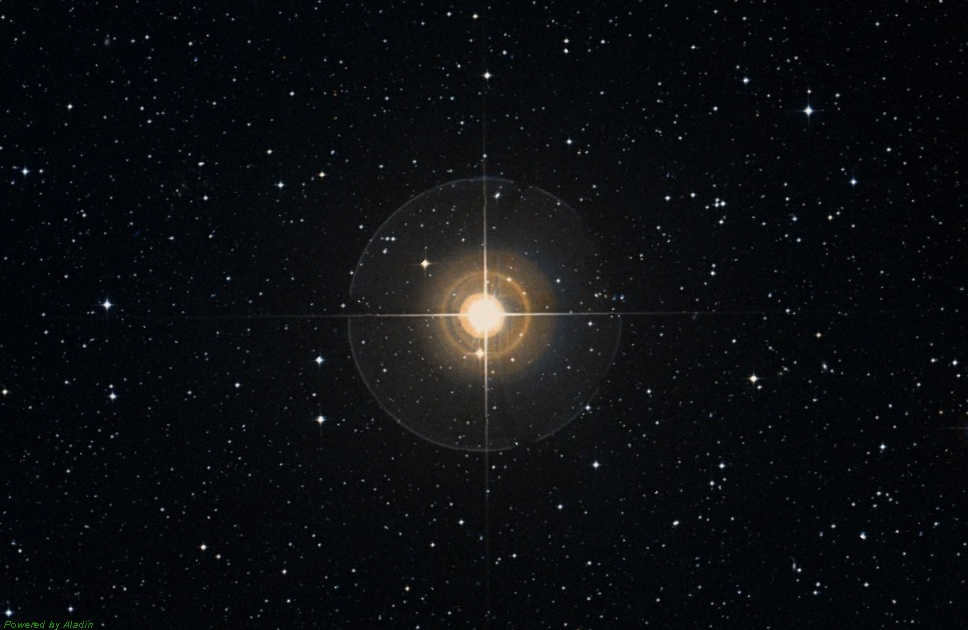
Gamma Libra is a typical orange giant star that falls into the K0III spectral class. This star has an effective surface temperature of 4822 Kelvin and has a diameter equivalent to 14 times that of the Sun. Its apparent magnitude is 3.93m, making it 71 times brighter than the Sun.
The metallicity of Gamma Libra is approximately half that of the Sun, and it has a mass of 2.5 times that of the Sun. The star is estimated to be around four billion years old. Additionally, a potential companion has been discovered in close proximity to Gamma Libra, less than 0.1 arc second away from the main star. This companion has a stellar magnitude of 4.2m and is classified as a G8III star on the spectrum. It is also likely to be a binary star system in its own right.
Delta Libra is a celestial body in the constellation Libra
An intriguing entity within the Libra constellation is the Delta star. It is also known by the name Zuben Elakribi. This alternative name implies that, like numerous other elements within Libra, it was once part of the neighboring Scorpius constellation. Delta Libra is also classified as a multiple system. Additionally, it serves as a notable example of eclipsing variable stars, specifically those of the Algol type.
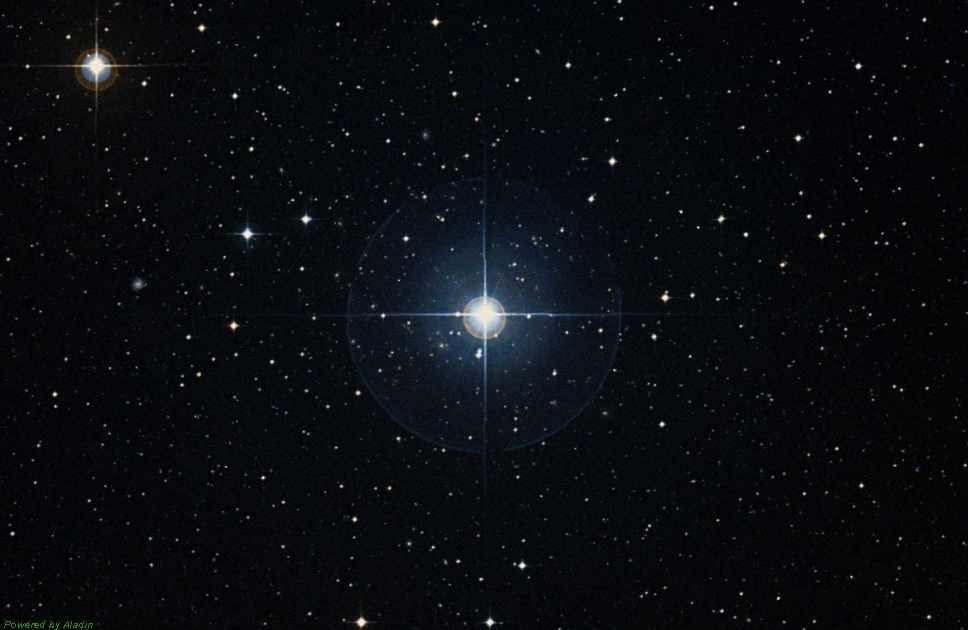
When browsing the variable star catalog, one can observe that the dominant component of this system is a star emitting white hot light, classified as class A0 based on its spectrum. The second component is a subgiant star with an orange hue. The two luminaries in this system are separated by a distance of approximately 9 million kilometers, and they complete an orbital cycle in about 2.5 days.
In 2001, there was a report suggesting the existence of an additional element in the binary system. This new element was believed to be a G9 class star with a mass similar to that of the sun. Its orbital period was estimated to be around 2.76 years. This information was later validated in 2006, confirming that this component is located at a distance of 4 astronomical units from the two stars.
There is another fascinating element in the arrangement of the constellation – this can be observed in the sigma of Libra. In the past, it has been known by different names, including Cornu, Bahrium, or the already familiar Zuben Hakrabi. It is worth noting that for an extended period of time, it was considered a legitimate part of the Scorpius constellation. However, due to its significant distance from its original constellation and its proximity to the prominent stars of Libra, astronomer Gould made the decision in the 19th century to reassign it to Libra and designate it as Sigma.
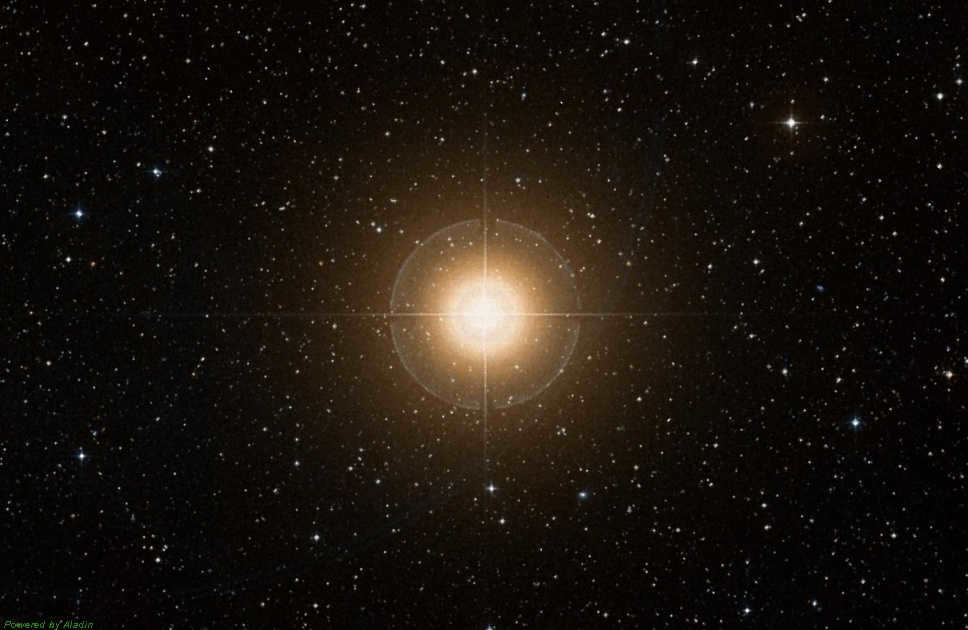
Sigma Libra is a pulsating star that exhibits variability in its brightness. It has a magnitude of approximately 3.29m, making it visible to the naked eye. The star belongs to the spectral class M3, which suggests that it is likely a red giant. It is located at a distance of 290 light-years from Earth. Compared to the Sun, Sigma Libra has a much higher luminosity, estimated to be around 1900 times greater, and a significantly larger radius, about 110 times larger. The star’s surface temperature is measured to be approximately 3600 K, giving it a reddish appearance.
It is worth noting that Libra sigma is a pulsating star. Therefore, its luminosity varies by an average of 0.26m every 20 days. This celestial object is in the advanced stage of its stellar life cycle. Extensive research has been conducted on all aspects of this star: there is no evidence of any unknown companions, anomalies in its chemical composition, or the presence of dust disks nearby. In the near future, the star will expand in size, shed its outer shell, and eventually transform into a white dwarf, exposing its carbon and oxygen core.
Fascinating items within the Libra constellation
The intriguing Gliese 570.
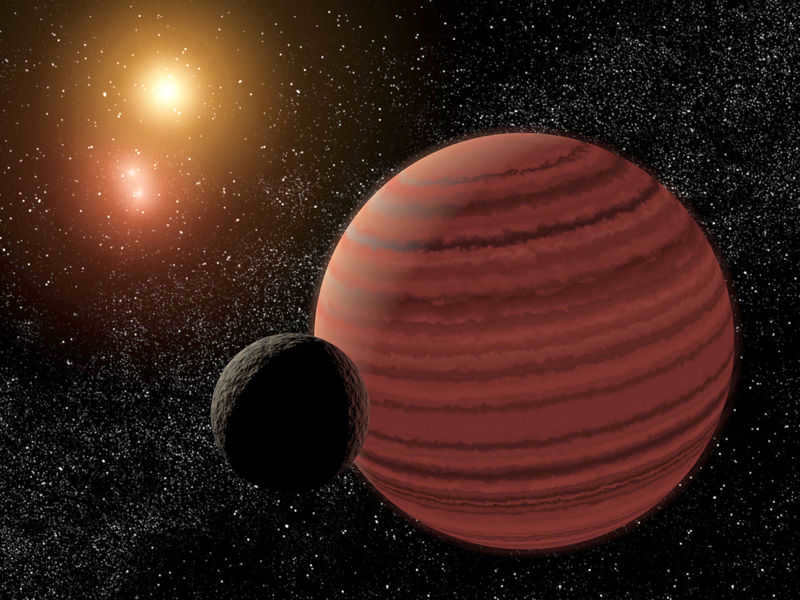
The artistic representation shows the Gliese 570 system.
Regrettably, individuals with a keen interest in astronomy will not discover any exceptionally luminous galaxies within the arrangement of this constellation. However, there exist several highly remarkable entities within the constellation. One such entity is the star Gliese 570, which holds the distinction of being the nearest quadruple system to the Sun. It consists of four dwarf stars: an orange one, a brown one, and two red ones. Gliese 570 is situated at a distance of 19 light-years from the Sun.
The structure of this system is highly intricate. As a result, the two components known as B and C revolve around a shared center of mass. The distance between the stars is relatively small, approximately 0.79 astronomical units, leading to a complete revolution in 309 days. The primary star, Gliese 570A, is significantly farther away from this pair, at a distance of 190 astronomical units. Consequently, the orbital period of the B and C pair, in relation to star A, amounts to approximately 2130 years. All elements of this four-star system, including the less notable component D, are categorized as aging stars within the galactic disk.
Gliese 581C: The Enigmatic Exoplanet
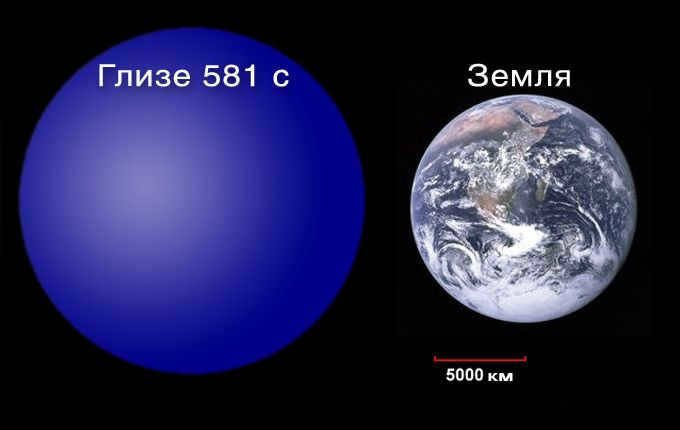
Comparison of Gliese 581C and Earth
In addition to the celestial object Gliese 570, Gliese 581C can also be observed in the Libra constellation. This planet is the first exoplanet ever discovered. It orbits around its host star, the red dwarf Gliese 581, within the habitable zone. Its discovery took place in 2007.
The Libra constellation did not always exist, but only emerged in the 2nd century BC. Prior to that, its stars were part of the Scorpius constellation, forming a figure resembling claws. This figure was known as the “Claws.” However, since the zodiac sign for this portion of the sky was called Libra, it started being referred to as Libra around the 1st century BC. Nevertheless, the brightest stars of the Libra constellation, known as alpha and beta, are still referred to as the South and North Pinches.
Among all constellations, Libra ranks 29th in terms of sky area. However, this constellation does not contain any objects from the Messier catalog. The main attractions here are primarily the stars.
Origins of the Constellation Libra’s Name
Since this constellation was originally part of Scorpius, there are no specific legends associated with it. Interestingly, Libra is the only zodiacal constellation that represents an object rather than a living being.
However, there is a theory behind the name Libra. When this constellation became independent, the Sun was positioned in it during the autumnal equinox. This resulted in a balance between day and night, with both having equal duration. Therefore, the name Libra has a practical justification.
The ancient Babylonians had observed the equinox point in the constellation of Libra for a millennium before the birth of Christ. This region of the sky was referred to as the “celestial balance”.
From 729 onwards, the equinox point shifted to the constellation of Virgo, where it has remained up to the present day. It will only move to the constellation of Leo in the year 2439.
The position of the Libra constellation in the celestial sphere
Situated between Virgo and Scorpio, the Libra constellation can be found in the night sky. Its optimal visibility occurs during the spring season, when it reaches a sufficient altitude above the horizon. This celestial formation can be easily identified by the luminous stars of its neighboring constellations – Spica and the reddish Antares – located in the southern region of the sky. The ideal time to observe the Libra constellation is during the spring and summer months.
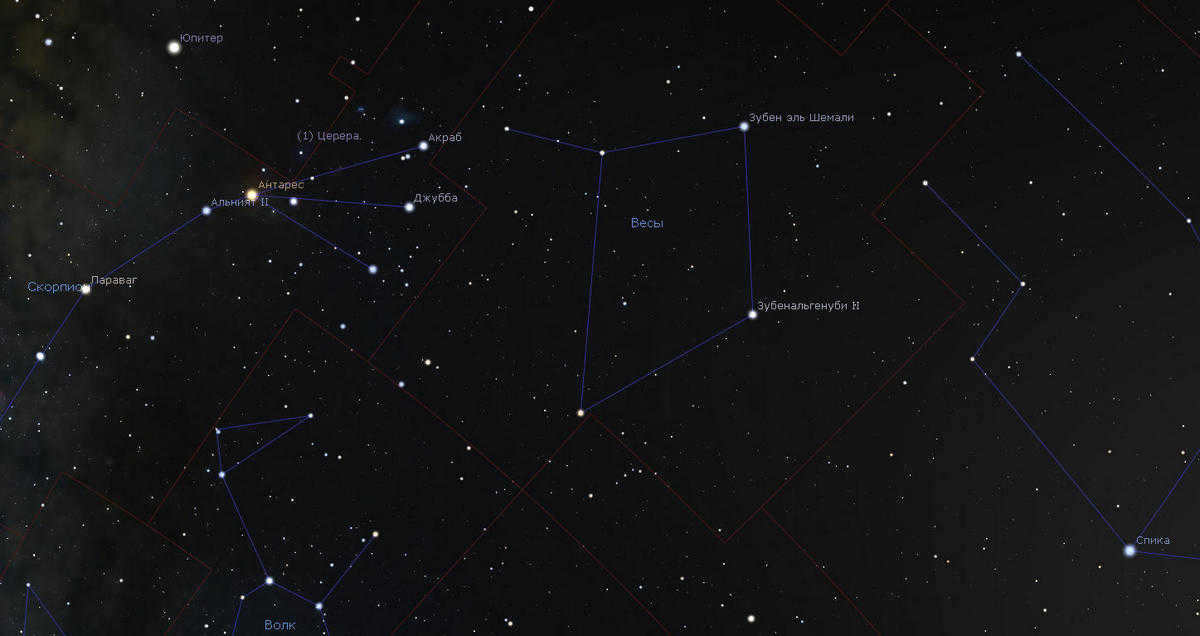
Stars in the Libra constellation
Given that the Libra constellation lacks distinctive features other than its stars, it is worth examining them in more detail.
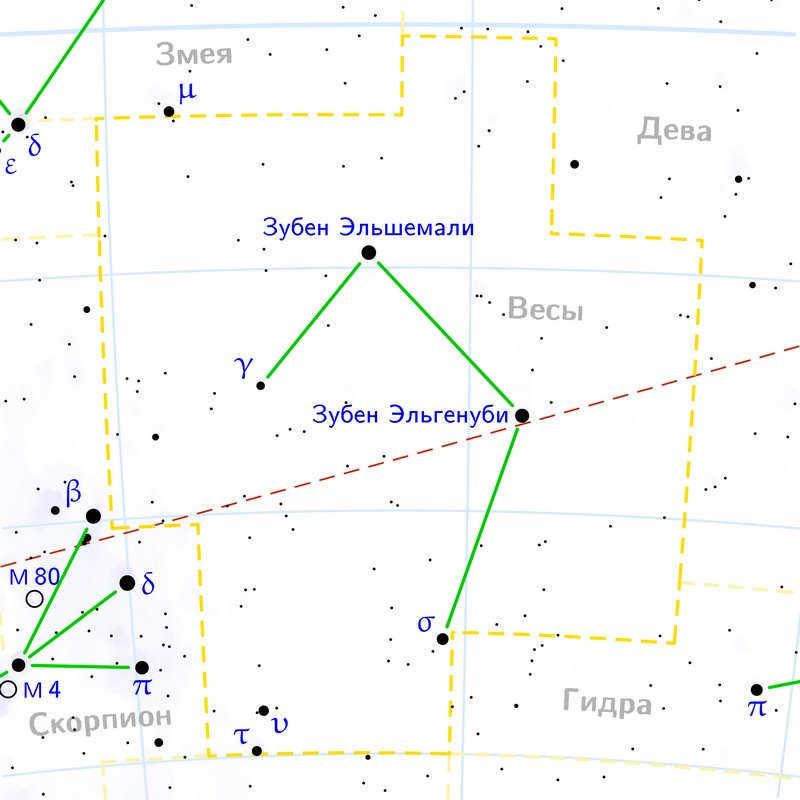
Zuben el Genoubi is the primary star of the Libra constellation.
Also known as the Southern Claw, Zuben el Genoubi is the brightest star located at the bottom of its constellation. It is visually double, consisting of two stars with brightness ratings of 2.75m and 5.15m. These stars are separated by 5 angular minutes and are easily distinguishable when viewed through binoculars. The brighter star is blue and hot, while the fainter star is yellow, creating a visually stunning pair. Despite their proximity, it remains uncertain whether these stars are physically connected. Interestingly, both components of this pair are themselves close doubles. Another nearby star, KU Libra, could potentially be the fifth component of this system. If all these stars are gravitationally bound, Zuben el Genoubi would be considered a quintuple star.
Known as the “Northern Claw,” this celestial body resides at the pinnacle of the constellation. Despite being labeled as beta, it outshines alpha and holds the title of the brightest star in the constellation. This blue-white main-sequence star has a variable luminosity, ranging from 2.60 to 2.63m. With a size only 1.2 times that of the Sun and a scorching surface temperature of 12,000 K, it radiates 130 times more light than our own star.
There remains a mystery surrounding the variability of Zuben el Shemali. One possibility is that it has a close companion that intermittently eclipses it. Interestingly, ancient astronomers Eratosthenes and Ptolemy observed that this star was much brighter during their era compared to its current luminosity. The reason behind its fading brilliance remains elusive.
Delta Libra – Zouben Elakribi
This star, known as Delta Libra, is classified as an eclipsing variable of the Algol type. Its brightness fluctuates between magnitudes 4.91 and 5.90, making it easily observable to the naked eye or through binoculars. With a period of 2.327 days, it completes a full cycle of variation within this time frame. Additionally, this system is not just a double system, but actually consists of three components.
Gliese 581.
Gliese 581 is a red dwarf star situated in the celestial sphere slightly above Beta Libra. This star holds significance as it is one of the nearest to our own, with a distance of approximately 20.3 light-years. With a magnitude of about 10.56m, it can only be observed through a telescope, even a modest one. What truly sets Gliese 581 apart is its possession of a planetary system, one of which resides within the habitable zone and has garnered immense interest.
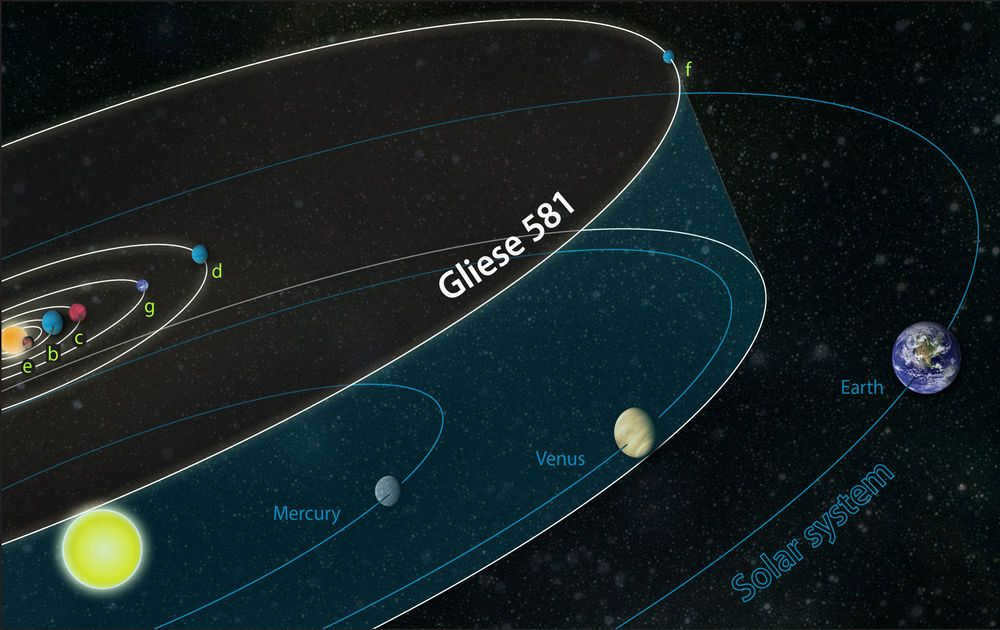
All the planets that we currently know of in the Gliese 581 system could easily fit within the orbit of Venus. The central star in this system is a red dwarf, which is smaller and cooler than our own Sun.
HD 140283, also known as Methuselah, is an incredibly old star.
This star may not look particularly special, but it is actually a subgiant with a brightness of 7.2m, making it visible through binoculars. It is worth seeking out and taking a look at this star, as it is estimated to be around 13.3 billion years old, making it one of the oldest stars in existence. In fact, it is one of the oldest stars that can be observed from the northern hemisphere. Despite its age, it is relatively close to us, as it is only 190 light-years away. However, it is nearing the end of its life as it has almost exhausted its hydrogen supply.
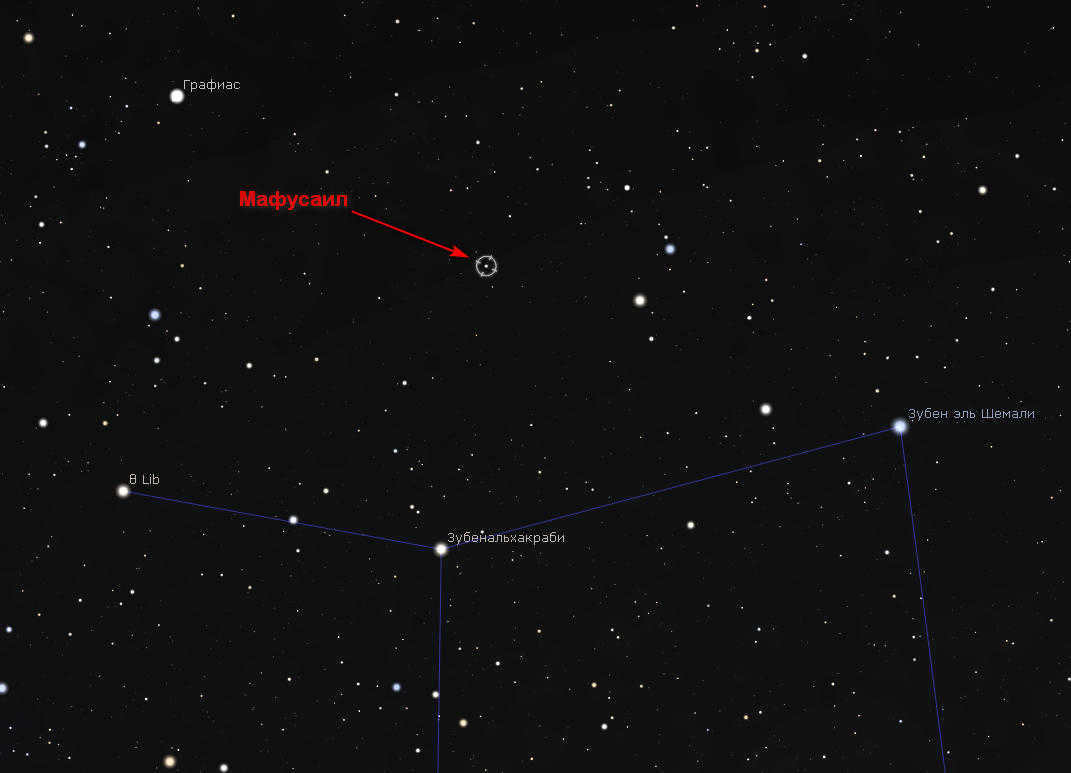
The constellation of Libra is home to a remarkable star known as Methuselah. This celestial body’s age is just a little bit younger than the age of the entire universe.
There is another star, with an astounding age of 13.7 billion years, although it can only be observed through a rather strong telescope due to its position in the southern constellation of Southern Hydra.
Galaxies and star clusters in the constellation of Libra.
Aside from stars, the constellation of Libra is also home to other celestial objects, such as galaxies and star clusters. However, these objects may appear faint to the naked eye and require the use of a sufficiently powerful amateur telescope to observe.
NGC 5792
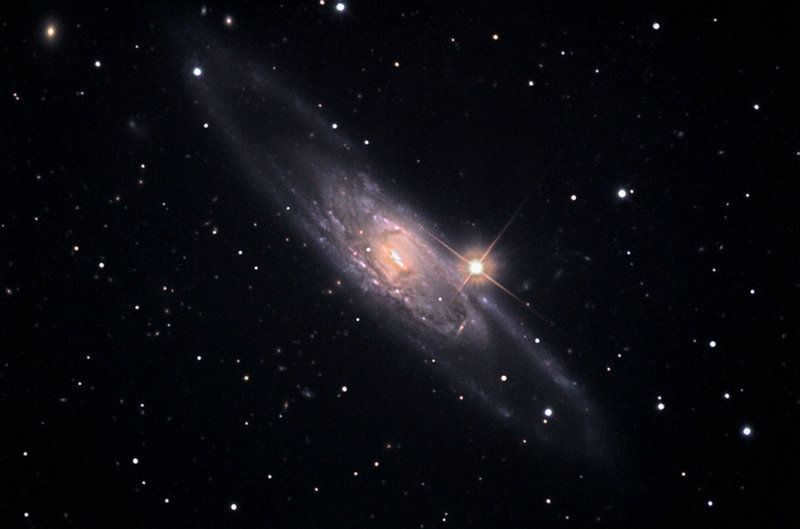
The NGC 5792 galaxy can be found in the constellation of Libra.
This galaxy is a spiral one with a distinct junction. It is positioned at an angle, giving it a resemblance to the well-known Andromeda galaxy M31.
The distance to NGC 5792 is approximately 83 million light years. It has an apparent brightness of 11.3m and a surface brightness of 13.8m. To observe it properly, it is recommended to use a telescope with an aperture of 200mm or larger.
NGC 5890: The Jewel of the Night Sky
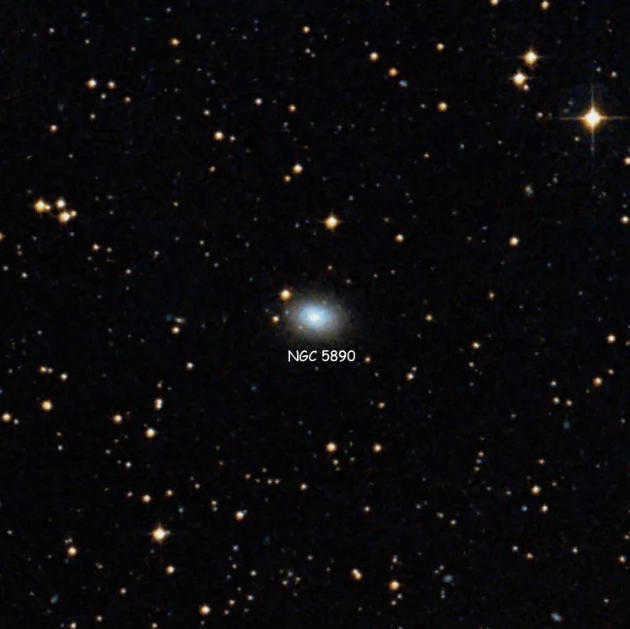
NGC 5890 is a lenticular galaxy located in the Libra constellation.
This galaxy has an apparent brightness of 12.8 and a surface brightness of 13.0m. It can be observed with large amateur telescopes, but it may not be visible with smaller ones.
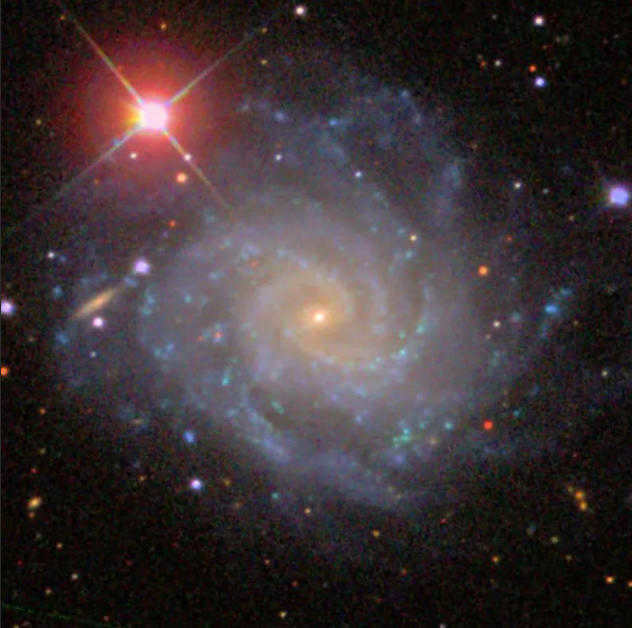
The NGC 5885 is a spiral galaxy located in the constellation Libra. It is characterized by an apparent brightness of 11.8m and a surface brightness of 14.2m, making it a challenging object to observe. Only those who possess sufficiently powerful telescopes can access and study this celestial wonder.
Exploring NGC 5897
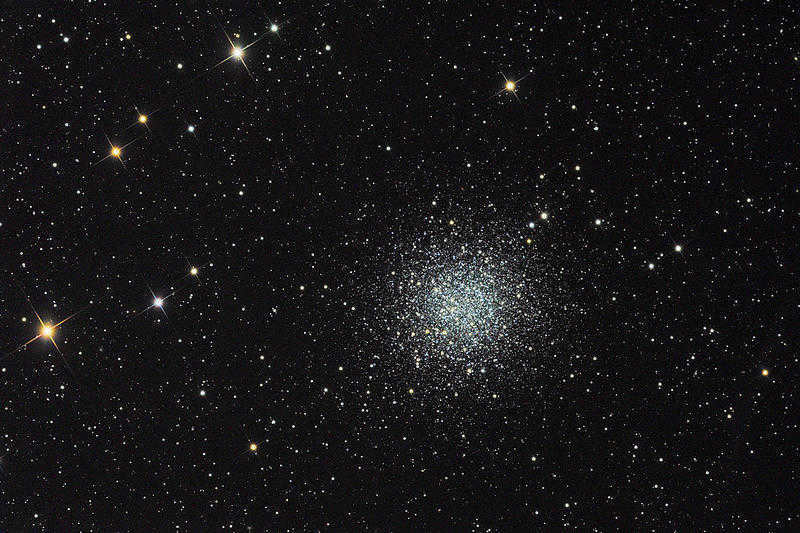
The globular cluster NGC 5897 can be found in the constellation Libra.
This particular globular cluster is unique in that it lacks a dense core. When observed, it appears as a spherical shape with individual stars becoming visible at the outer edges. Located approximately 45,000 light-years away, it has a brightness rating of 8.4m, making it a suitable target for observation even with smaller telescopes.
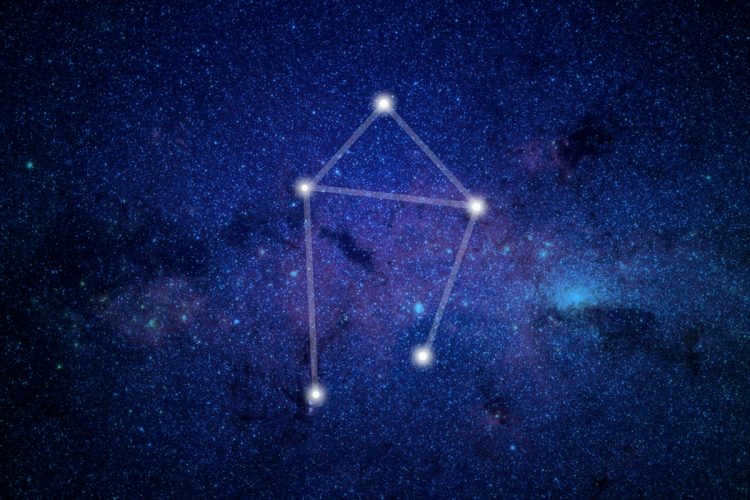
- Constellations
Libra is a constellation located between Scorpio and Virgo. It is home to 83 stars that can be seen with the naked eye. Despite having only six stars brighter than 4th magnitude, Libra is one of the most prominent constellations in the Zodiac.
This constellation did not always exist. It only emerged in the 2nd century BC. Prior to that, its stars were part of the Scorpius constellation, forming a figure resembling claws. This figure was known as “Claws”. However, since this part of the sky was associated with the sign of Libra, it started being referred to as Libra around the 1st century BC. To this day, the brightest stars in the Libra constellation are alpha and beta, known as South and North Pinches.
Signs
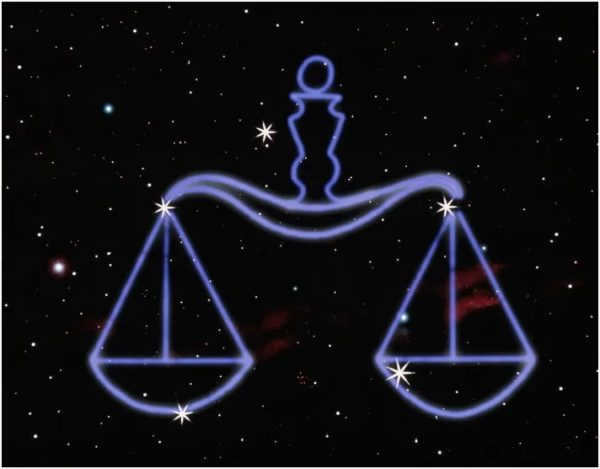
Starting from 1962, scientists from the Soviet Union and Russia have been consistently transmitting radio and laser signals towards the Libra constellation. This has been done four times in total, with transmissions occurring in 1962, 1966, 2008, and 2009. The purpose of these transmissions is to make contact with potentially habitable exoplanets.
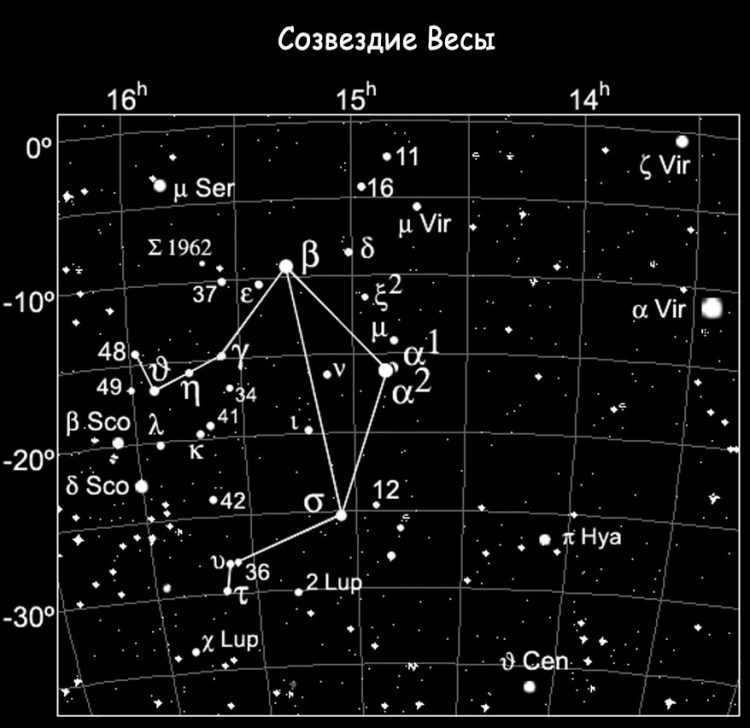
Beta Libra
Beta Libra is a blue-white dwarf located in the constellation Libra. It has an apparent visual magnitude of 2.61, making it the brightest star in the constellation. Beta Libra is located at a distance of 185 light-years from Earth. This star is known for its fast rotation, spinning at a speed of 250 km/s. It has a radius 4.9 times that of the Sun and is 130 times brighter.
One interesting characteristic of Beta Libra is its small periodic variations in luminosity. These variations, measuring 0.03 magnitudes, suggest the presence of a companion star.
Libra Alpha
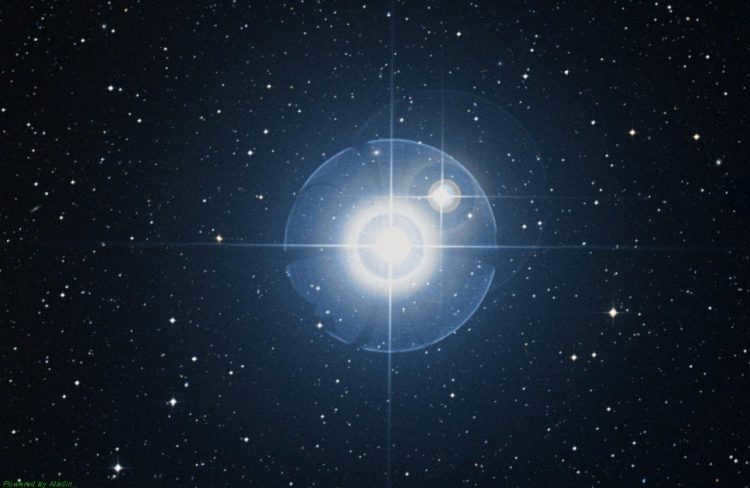
A binary star system, where the two brightest objects are a double star, have a shared proper motion in space. It could be a member of the moving Castor group, originating approximately 200 million years ago. The system is located close to the ecliptic and may be obscured by the Moon and planets. On November 10, 2052, it will be hidden from view by Mercury. It is the second brightest star in the constellation.
Alpha-1 Libra consists of two components that have an apparent visual magnitude of 5.153 and are 74.9 light-years away. It is a spectroscopic binary system (F4) with a rotation period of 5870 days. The two objects in the system are separated by 0.383 arc seconds (10 a.u.).
The fifth component, KU Libra, could potentially be connected to the other stars as it is only 2.6 degrees away and moving in the same direction. This star has the Arabic name “Zuben Elgenubi” which means “southern claw” and the Latin name “Kiffa Australis” which translates to “southern cup”.
Sigma Libra (Brachium).
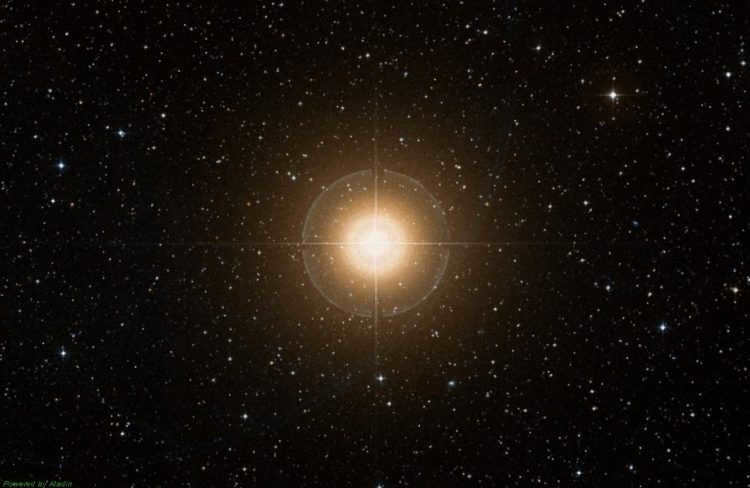
Sigma Libra is classified as a variable pulsating celestial body with a magnitude of approximately 3.29m. It belongs to the spectral class M3, indicating that it is probably a red giant. This particular star is situated at a distance of 290 light-years from our location. Its luminosity is estimated to be around 1900 times greater than that of our Sun, and its radius is approximately 110 times larger. The surface temperature of this reddish star is estimated to be about 3600 K.
Methuselah (HD 140283): A Unique Astronomical Phenomenon
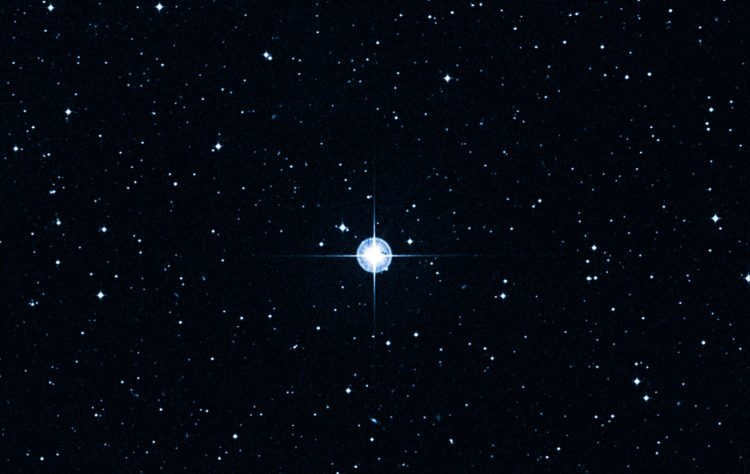
A subgiant and the oldest known star in the Universe, formed shortly after the occurrence of the Big Bang. It has an apparent visual magnitude of 7.223 and is located at a distance of 190.1 light-years. This star possesses a small amount of metal, but contains significant quantities of hydrogen and helium. The iron composition is less than 1%. Its age is estimated to be 14.46 billion years, while the age of the universe is approximately 13.77 billion years. These figures are not in conflict, as they are approximate values that cannot be precisely calculated.
By utilizing the Hubble Space Telescope, scientists were able to determine that the star HD 140283 is approximately 14.5 billion years old (+/- 800 million). It is currently moving rapidly through the nearby region of stars. The star’s orbit takes it across the plane of our galaxy from a galactic halo that consists of ancient stars. Captured in blue light by Schmidt’s telescope.
Ipsilon of Libra
Ipsilon of Libra is a multiple star system located 195 light-years away. It is an orange giant (K3III) with an apparent visual magnitude of 3.60.
Tau of Libra
Tau of Libra is another star system in the constellation Libra. It is a blue-white dwarf (B2.5V) with an apparent visual magnitude of 3.66. Located 445 light-years away, it occupies 3.2 solar radii.
Libra Gamma
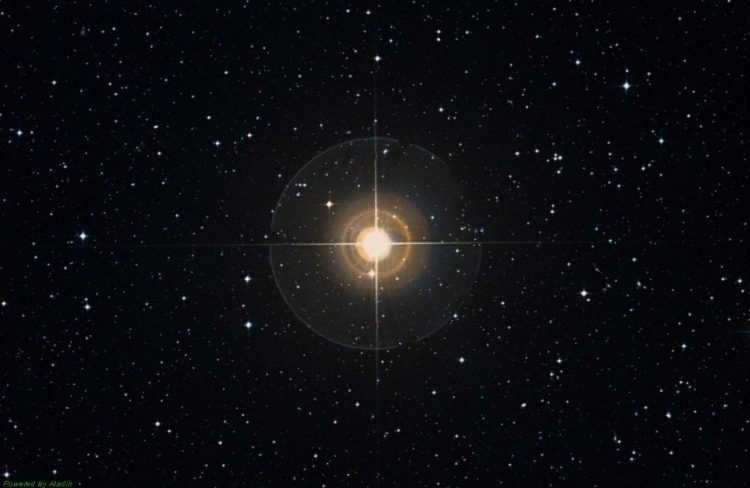
An orange giant star known as K0 III has an apparent magnitude of 3.91 and is located 152 light years away. With a diameter equivalent to 14 times that of the Sun, this star shines 71 times brighter than our own. Its Arabic name, “Zuben el Aqrab,” translates to “scorpion’s claw.”
The Libra gamma ray has a metallicity that is half of the Sun’s, and the star itself has a mass of 2.5 times that of the Sun. Estimates suggest that the star is approximately four billion years old. Additionally, a potential close companion has been detected in this system, located less than 0.1 arc seconds away from the main star. This companion, with a stellar magnitude of 4.2, is classified as a G8III star and may also be a binary star system.
Theta Libra
Theta Libra is an Orange Giant star (K0 III) with a visual magnitude of 4.136. It is located at a distance of 163 light-years from Earth. This star has a mass that is 84% greater than the Sun’s and is 35 times brighter.
Iota Libra
Iota Libra is a system represented by two pairs of stars. The first pair, Iota-1, consists of a subgiant star (B9) and a dwarf star. They are located 377 light-years away from us. The second pair, Iota-2, consists of a dwarf star (A3) located 240 light-years from the Sun. The apparent visual magnitude of Iota Libra is 4.54.
The stars in the Iota-1 pair orbit around each other with a period of 23.469 years. They are separated by 0.13 arc seconds. The total mass of Iota-1 is 6.05 times that of our Sun, and the stars are 149 and 94 times larger in size. Additionally, there are a couple of other dwarf stars (G) in this system with magnitudes of 10 and 11.
Libra Delta
can be phrased as “The Delta of Libra” or “The Libra Change”.
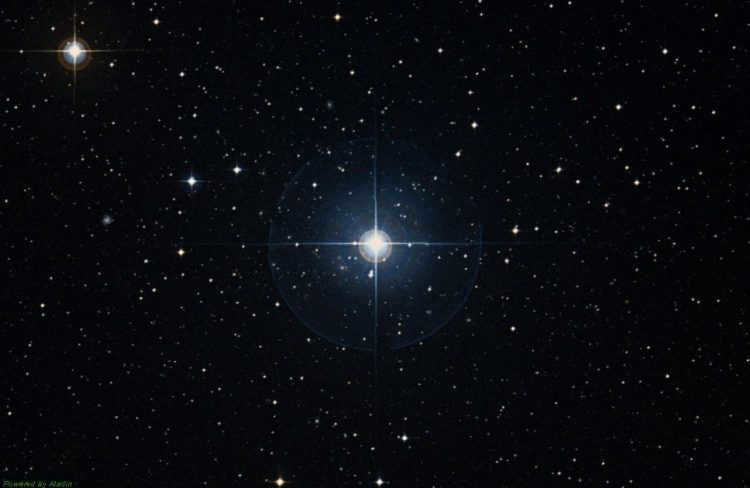
One intriguing celestial object located in the constellation of Libra is known as Delta. Another moniker for this bright star is Zuben Elakribi. This alternate name serves as an indication that, like numerous other components within Libra, it was previously part of the neighboring Scorpius constellation. Delta Libra is also classified as a multiple system. Additionally, it is an prominent example of eclipsing variable stars, which belong to the Algol type.
Upon perusing the variable stars catalog, it becomes apparent that the primary component of this system is a scorching white star, assigned a classification of A0 based on its spectrum. Its secondary component is an orange subgiant. The distance between the two stars in this system measures nearly 9 million kilometers, and their orbital period lasts approximately 2.5 days.
48 Libra
48 Libra is a massive blue supergiant star, classified as B8Ia/Iab, with a visual magnitude of 4.94. It is located approximately 515 light-years away from Earth. This star has a mass of about 5.8 times that of our Sun, making it extremely massive. It is also about 3.3 times larger in radius and shines about 965 times brighter than the Sun.
What makes 48 Libra even more remarkable is its high rotational velocity, which reaches an incredible speed of 400 km/s. This fast rotation causes the star to exhibit irregular variations in brightness. As a result, the star ejects equatorial gas and forms a gaseous equatorial disk around it.
Gliese 581
is a red dwarf star located 20.3 light-years away from Earth in the Libra constellation. It has attracted a lot of attention from astronomers due to the discovery of several exoplanets in its orbit. The most notable of these is Gliese 581d, a potential habitable planet that could potentially support liquid water on its surface. This has sparked speculation about the possibility of extraterrestrial life existing in this distant star system. Further studies and observations are needed to fully understand the nature of Gliese 581 and its planetary system.
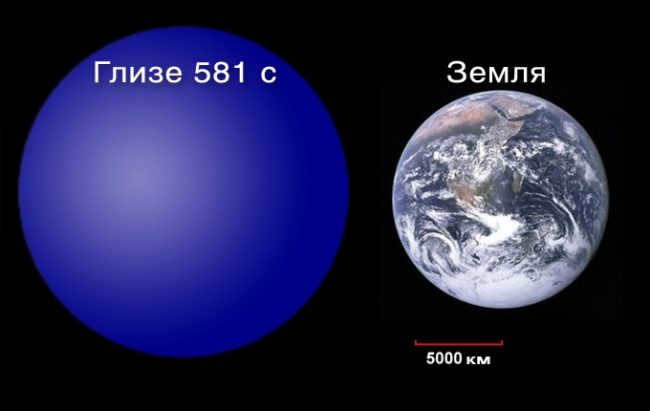
Comparison of Gliese 581C and Earth
Gliese 581C is a red dwarf (M3V) with an apparent magnitude of 10.56-10.58 and is located 20.3 light-years away. It is the 89th closest star to our solar system and has a mass that is one-third of the sun’s and a visual luminosity that is 0.2% of the sun’s. It is situated 2 degrees north of Beta Libra.
Gliese 581C is classified as a BY Dragon type variable star, which means it is a main sequence K or M class star that exhibits variations in luminosity due to rotation and the presence of starspots. It has between 3 and 6 planets, with the first one being discovered in April 2007. However, Gliese 581C is too close to its star and may have a similar environment to Venus. On the other hand, Gliese 581D is located in the habitable zone or possibly outside of it. The least massive planet in the system is Gliese 581E, which was found in April 2009.
In September 2010, scientists detected the presence of another planet. If this finding is verified, it would be considered the most favorable for the existence of liquid water, as it falls within the habitable zone. Furthermore, in November 2012, the European Space Agency made an intriguing discovery: a belt of comets containing ten times more comets than our own solar system.
23 Libra.
This star, known as 23 Libra, is a yellow dwarf (G5 V) with a visual magnitude of 6.45. Located at a distance of 85 light-years, it is home to two planets that were discovered in 1999 and 2009. Remarkably, 23 Libra is significantly older than our Sun, with an estimated age of 8.4-11.1 billion years. Moreover, it exceeds the Sun in terms of mass (107% of solar mass) and radius (125% of solar radius).
HD 141937
A yellow dwarf star known as HD 141937, classified as a G2/G3 V type, has a gas giant planet in its orbit. This gas giant planet was discovered in 2001. HD 141937 is similar in mass to our Sun and has a radius that is 1.06 times larger than the Sun. It has an apparent visual magnitude of 7.25 and is located approximately 109 light-years away from us.
Gliese 570
Gliese 570 is a star system consisting of at least three stars. It is located 19 light-years away from us and can be found in the southwestern part of the constellation. Specifically, it is situated southwest of Alpha Libra and northwest of Sigma Libra.
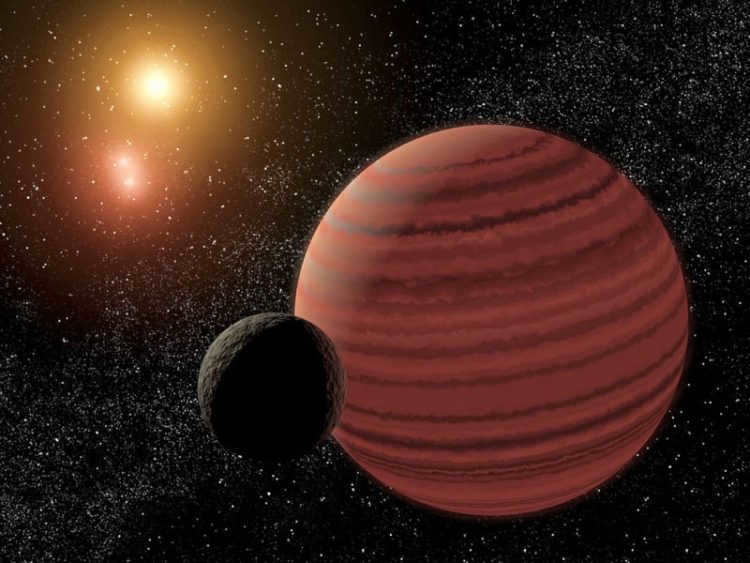
Gliese 570, as depicted by the artist
The structure within this system is rather intricate. Thus, the two components known as B and C share a common center of mass around which they revolve. The proximity between these stars is relatively close – approximately 0.79 astronomical units, resulting in a revolution completed within 309 days.
The primary component known as the star Gliese 570A is situated 190 astronomical units away from the pair. As a result, the revolution of the B and C pair, in relation to the star A, takes approximately 2130 years. All elements of this quadruple system, including the least notable (dim and small) component D, are classified as aging stars of the galactic disk.
Fascinating subjects for observation
1. NGC 5897, a globular star cluster
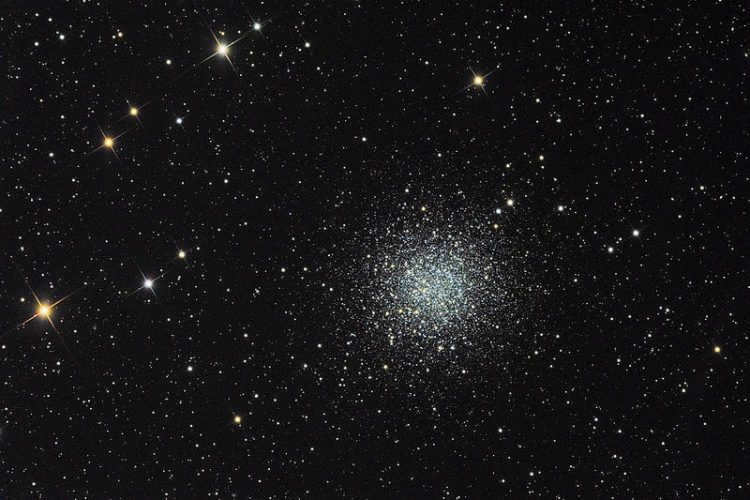
NGC 5897 is a massive spherical cluster of stars with an irregular and rounded structure. It has a magnitude of approximately 8.6 m and an apparent size of 11.0′.
When observed through high-quality binoculars, NGC 5897 appears as a hazy patch without any distinctive characteristics. However, in small telescopes used by amateur astronomers, it is possible to discern several bright, individual stars that are clearly separate from the cluster.
2. NGC 5885: A Stunning Spiral Galaxy
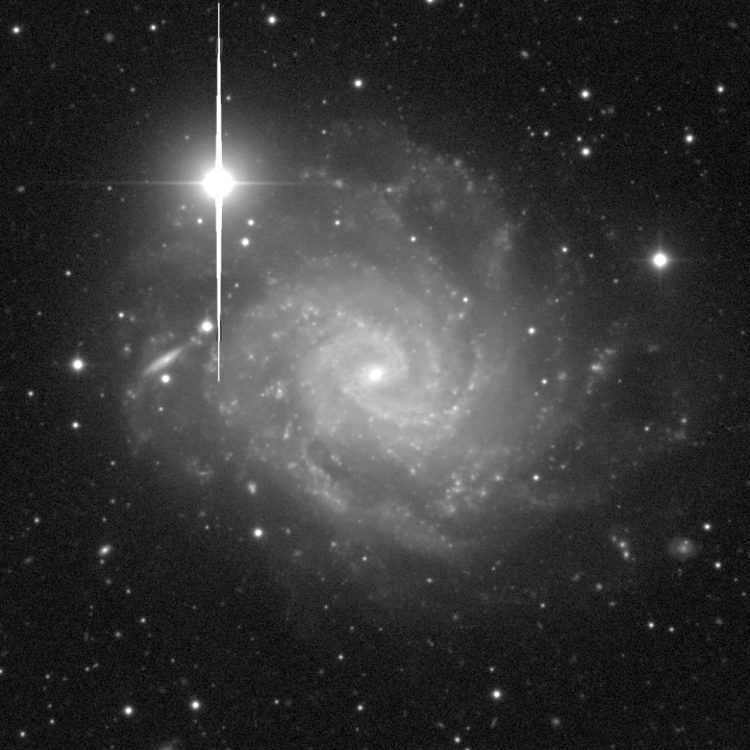
NGC 5885 is a spiral galaxy with a relatively low brightness of 11.8 m. When observing it through a semi-professional telescope with a 150 millimeter or larger objective lens, it appears as a small, blurred bright area. However, when using an aperture of 200 millimeters or greater, it becomes possible to distinguish individual regions and, under optimal weather conditions, even discern the galaxy’s arms.
To locate NGC 5885, one can start by finding the star Zuben Elshemali and then moving towards one of the dimmer stars in that vicinity. By using the selected star as a reference point, a slight adjustment in the right direction will lead to the discovery of the galaxy NGC 5885.
3. NGC 5792: A Fascinating Spiral Galaxy.
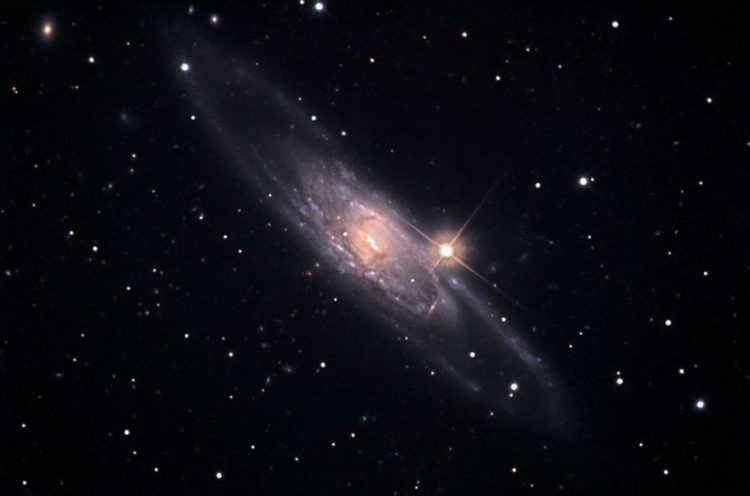
This galaxy has a distinctive spiral shape with a junction. It is positioned at an angle, giving it a resemblance to the well-known Andromeda galaxy M31.
NGC 5792 is located approximately 83 million light years away. It has an apparent brightness of 11.3m and a surface brightness of 13.8m. To observe it, it is recommended to use a telescope with an aperture of 200mm or larger.
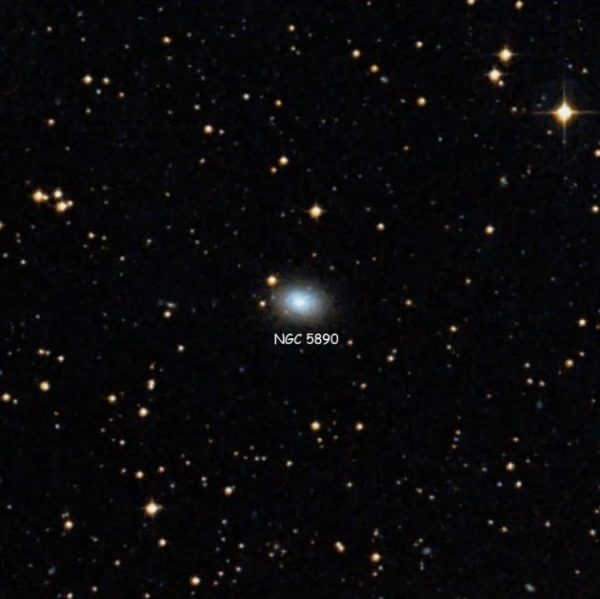
This galaxy is known as a lenticular galaxy, and it has an apparent brightness of 12.8 and a surface brightness of 13.0m. While it can be observed using large amateur telescopes, it will not be visible with a smaller one.
Locating a specific constellation in the night sky
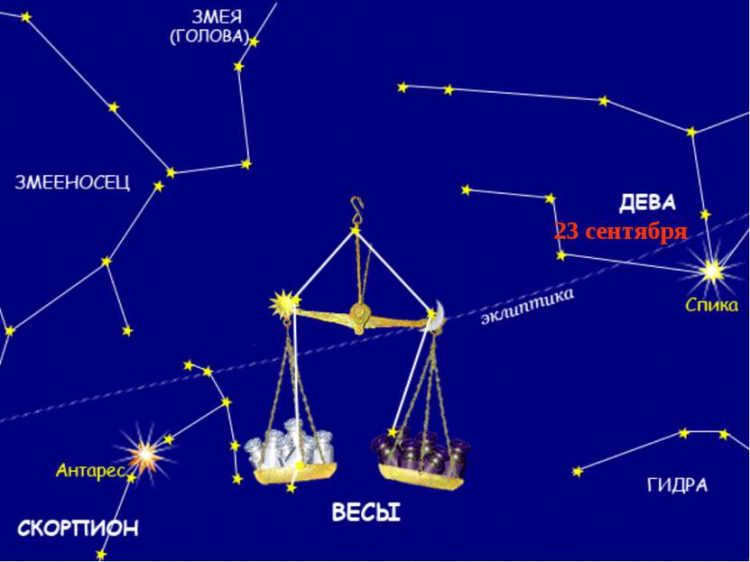
Spotting Libra in the night sky is a fairly easy task. This constellation takes the shape of a rhomboid, which is formed by its four brightest stars. These stars are not positioned high above the horizon as they are located in the southern hemisphere. Observing this constellation is effortless during the period from April to May. In the southern and central regions of Russia, the entire constellation can be seen.
As for the Sun, it is positioned in Libra from the end of October (October 31) to the twentieth of November (November 22). Additionally, the two neighboring constellations of Libra are Serpens, the Serpent, and Lupus, the Wolf.
The Origin of the Libra Constellation
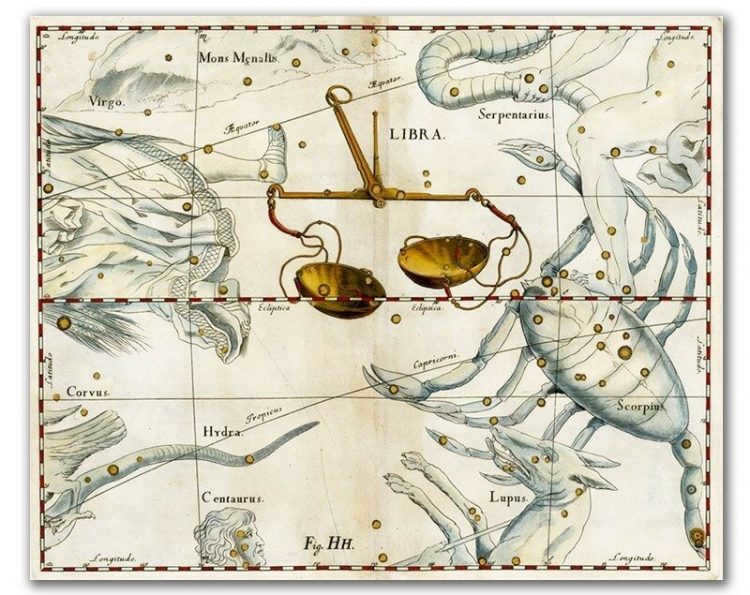
The legend of ancient Greece tells the following story about Libra. In a time long ago, the laws of the galaxy and the earth were governed by Zeus. He resided on the remote Mount Olympus. Zeus’ rule was strict and unforgiving. Justice was entrusted to his wife, the goddess Themis. She arranged gatherings at the cosmic table and established meetings for the people on Earth. Upholding the laws was Themis’ main responsibility.
During an era known as the universal time, a daughter named Dike was born to Zeus and Themis. As she matured, Dike was given the important task of traveling throughout the Earth with her scales in order to measure the actions and thoughts of individuals. Dike diligently journeyed across the planet, blindfolding herself to ensure the objective evaluation of people’s deeds. Upon her return to her father Zeus, she recounted the injustices she had witnessed on Earth. In response, Zeus harshly punished those who had failed to adhere to his established laws. As a result, the Scales of universal justice, known as Dike’s scales, were immortalized in the sky. Their purpose was to serve as a constant reminder to the people of Earth about the critical importance of upholding and respecting the laws.
Astrology
Individuals born between September 23 and October 22 are governed by the astrological forces of the Libra constellation.
It is important to note that the Libra sign should not be mistaken for the Libra constellation, which the Sun occupies from October 31 to November 22.
Libra is an Air sign that belongs to the Trigon group. Venus and Saturn are regarded as the ruling planets of the Libra sign.
“There are two signs that are named after the equinox: Aries, which follows the vernal equinox, and Libra, which follows the autumnal equinox. These signs are also named because of what happens in them, as the Sun being at the beginning of these signs is characterized by the equal duration of day and night.”
– Claudius Ptolemy, On the Influence of the Stars, “A Mathematical Treatise in Four Parts”
“Constellation Libra” is a part of the ongoing “Constellation” series of publications, initiated in response to a request from a school astronomy teacher (Forum).
– Astronomy is currently an elective subject and not mandatory for students.”
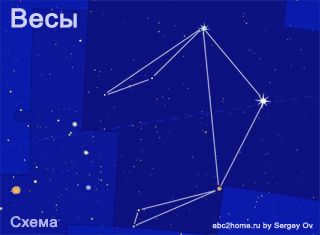
Figure 1 Illustration of the Libra constellation ♎ , diagram
The constellation of Libra (♎, Libra) is the seventh largest constellation in the zodiacal group 1. Among all the constellations in the celestial sphere (firmament), Libra ranks 29th, and among the constellations in the Southern Hemisphere, it ranks 10th (538 sq. deg.). The lines of the celestial equator and the ecliptic pass through the constellation, with most of Libra located above the ecliptic line but below the celestial equator, making it part of the southern sky.
The constellation of Libra is situated south of the celestial equator and is surrounded by lesser-known constellations to those in the north, such as the Serpent, Serpentor, Scorpio, the Wolf, the Hydra, and Virgo. Knowing how to locate this zodiac constellation can be helpful.
The Sun is currently passing through the constellation Libra from October 31st to November 22nd, within just three weeks: Libra (Libra, ♎) is one of the three smallest zodiac constellations in the modern starry sky along the ecliptic!
The best time to observe the Libra constellation is between May 1 and May 23 (Libra culminates at midnight).
Stars and a diagram illustrating the arrangement of the Libra constellation
To create an outline depiction of the balanced scales with bowls, it is sufficient to utilize the seven most prominent stars within the constellation. These include two stars of 3rd magnitude, namely Zuben Elgenuby (α Lib; 2.75) and Zuben Elshemali (α Lib; 2.75), as well as five stars in proximity to the 4th magnitude: σ Lib; 3.25, υ Lib; 3.60, τ Lib; 3.66, γ Lib; 3.98, θ Lib; 4.1. The schematic representation (diagram) of the constellation can be observed in Figure 2:
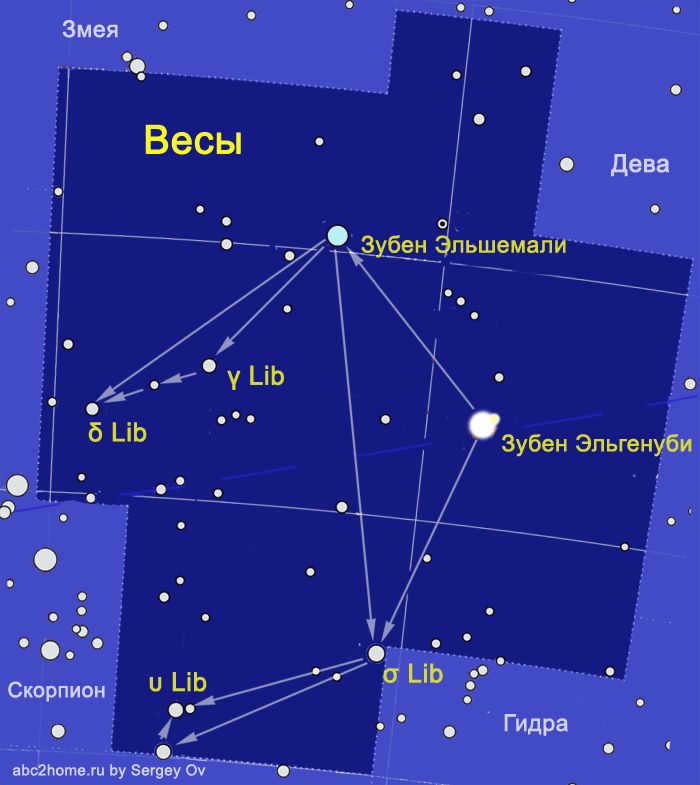
Figure 2 The Libra constellation (♎, Libra – Latin). The most prominent stars.
A depiction of the Libra constellation, which may have established the current boundaries of the constellation
Ancient astronomers, who passed down the modern boundaries of the constellations to us, primarily resided in tropical and subtropical latitudes and observed the zodiacal belt stars differently from how we, the Northern inhabitants, perceive them. In Athens and especially Alexandria, where the constellations of the zodiac are near the zenith and the ecliptic line is nearly perpendicular to the horizon, the Libra constellation, which rises in the east, appears as follows:
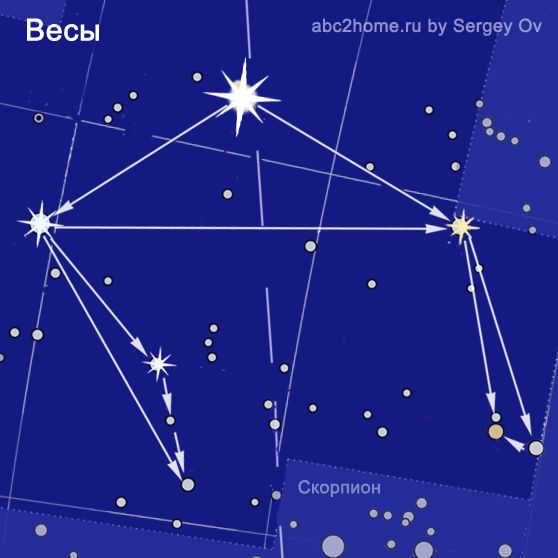
The diagram of the Libra constellation was created by Sergey Ov. This diagram depicts the southern sunrise of the constellation, and it is labeled as Figure 3. Despite the lack of bright stars and distinct contour images in the Libra constellation, Sergey Ov has presented his own interpretation of the stars’ arrangement in the form of a swing or a merry-go-round.
During the time of Ptolemy, all the constellations of the zodiac were considered to be alive, except for Libra, which did not have its own constellation. In the night sky, the area under the sign of Libra was divided equally between the constellations of Virgo and Scorpio.
In the part of the sky that corresponds to the modern constellation Libra, Claudius Ptolemy describes an asterism called “The Claws of Scorpius” in his catalog “Almagest” and, for some reason, treats it as a separate constellation. It was only towards the end of antiquity that references to the asterism “Libra” within the constellation of Scorpio began to appear, and it became a separate constellation during the time of the Roman Empire’s greatest power, when the goddess Justitia with scales in her hands was placed on a pedestal.
Therefore, it is best to observe the Libra constellation together with the northern part of its parent, the Scorpio constellation:
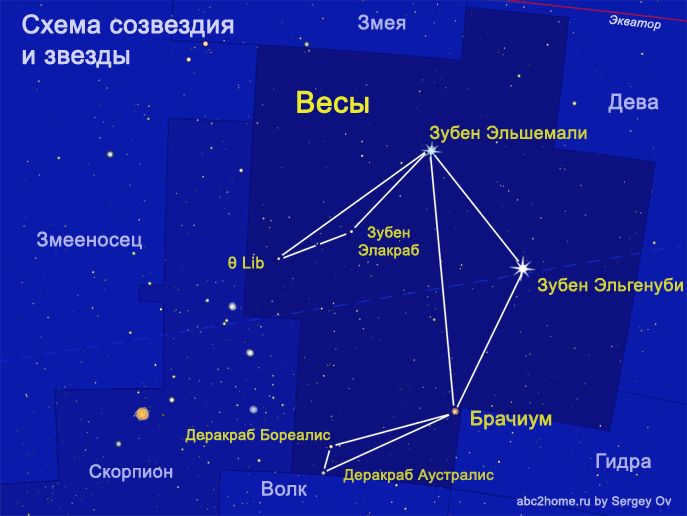
Constellation Libra is made up of stars and it is associated with balance and justice. One of the notable stars in this constellation is Sergey Ov.
Figure 4 Libra (♎, Libra – Latin) is the constellation that surrounds other constellations. The stars within the constellation form a diagrammatic image of Libra.
The arrangement of the stars in the diagram is as follows:
Zuben Elgenubi α Libra (α Lib) – Brachium (σ Lib) – Deracrabus Australis (τ Lib) – Deracrabus Borealis (υ Lib) – Brachium (σ Lib) – Zuben Elshemali (β Lib ) – Zuben Elacrabus γ Libra (γ Lib) – θ Libra (θ Lib) – Zuben Elshemali (β Lib) – Zuben Elgenubi α Libra (α Lib) . The constellation Libra can be observed from December to September. It reaches its highest point at midnight in May. There are a total of 83 stars within the constellation that can be seen with the naked eye.
To view a list of over 90 stars, please refer to the list:
Notable and Visible Stars of the Libra constellation. Ptolemy described the “Scorpion’s Claws” as a separate star formation, which is depicted in Figure 5. It is interesting to question why Ptolemy chose to create a separate constellation for this formation.
As a child, I was shown the “Pincher asterism” which can be used to locate the constellations of Scorpio and Libra. To see the asterism in the picture, simply hover over the image or double-click on it.
All the stars included in the asterism, even the faint ones, have their own names. The chain of stars begins with “fiery” Antares – Alpha Scorpio (α Sco), Aqrab (β Sco), Zuben Elshemali – Beta Libra (β Lib), Chubba (δ Sco), Zuben Elgenubi (α Lib), Vrishika (π Sco) and ends with Antares again. “Asterism Pincers, Scorpio Pincers, the constellations Scorpio and Libra”. The chart was created by Sergey Ov (Seosnews9) 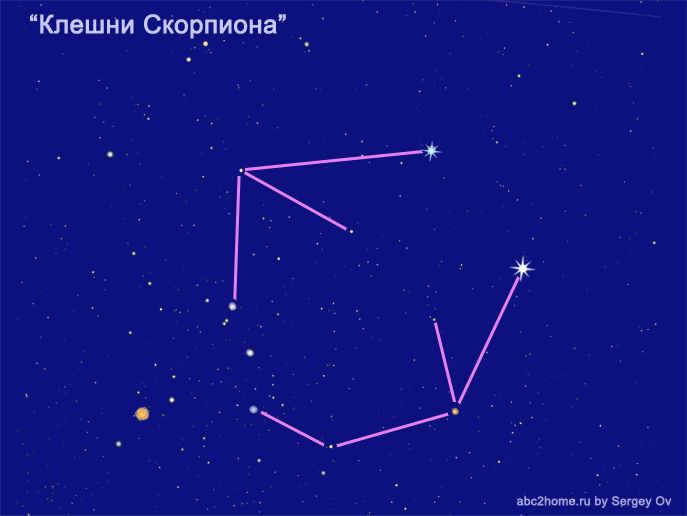 Asterism Pincers, Scorpio Pincers, constellation Scorpio and Libra. Chart created by Sergey Ov (Seosnews9)
Asterism Pincers, Scorpio Pincers, constellation Scorpio and Libra. Chart created by Sergey Ov (Seosnews9)
Discovering the position of the Libra constellation
To locate the Libra constellation, it is important to note that in middle latitudes, it does not rise high above the horizon and is fully visible only in the southern part of the sky.
The easiest way to find the three brightest stars of Libra (blue and white – bright, orange – dimmer) is by using neighboring constellations. However, it is necessary to be familiar with these constellations, and they may not always be visible or fully visible.
Many people have a great imagination when it comes to connecting stars, so let’s search for well-known star pairs and draw lines through them to point us towards the Libra constellation. 1. The quickest and most accurate method is from the Volopas constellation. If you know the Parachute asterism, choose two stars: Segin, Gamma of Volopas (γ Boo), located on the right edge of the “parachute dome”; Izar, Epsilon of Volopas (ε Boo), located in the middle of the left “sling”. Draw a line through them and follow it to the nearest bright star, Zuben Elshemali (Fig. 7) – this is the easiest and most accurate way to find the Libra constellation.
Remember that Volopas rises before Libra and sets later, so if Volopas is close to the horizon, it is pointless to search for Libra. 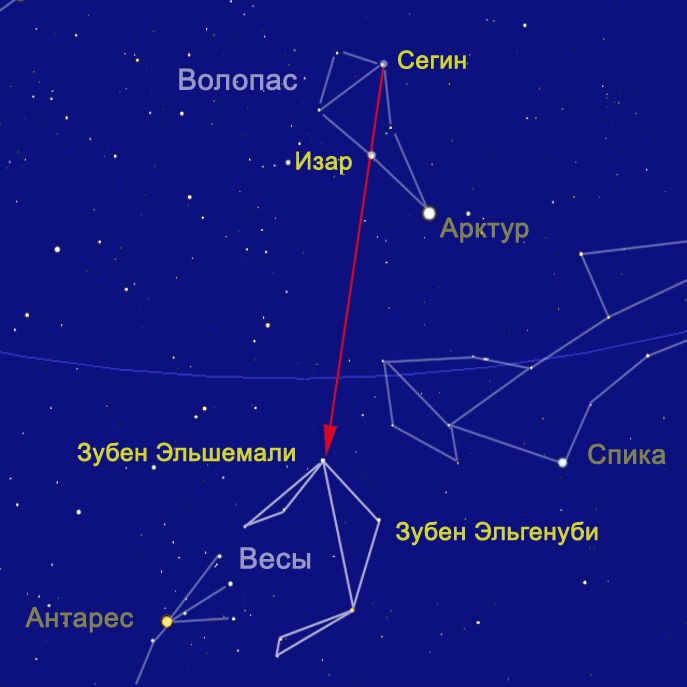 Fig. 7. How to find the Libra constellation using Volopas – a precise sighting of Beta Libra 2. The most versatile approach to locating Libra is from the north using the constellations of the Big Dipper, Little Dipper, or for more experienced observers, the constellations of Swan and Lyra (Fig. 8):
Fig. 7. How to find the Libra constellation using Volopas – a precise sighting of Beta Libra 2. The most versatile approach to locating Libra is from the north using the constellations of the Big Dipper, Little Dipper, or for more experienced observers, the constellations of Swan and Lyra (Fig. 8): 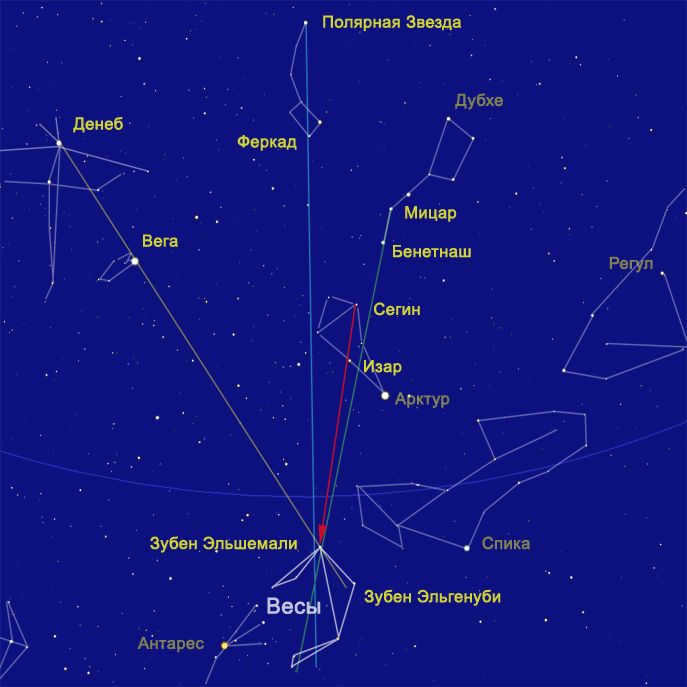 Fig. 8. How to find the Libra constellation based on the northern part of the sky For beginners, the easiest way to find Libra is by using the stars of the Big Dipper located on the handle, specifically the pair Mizar – Benetnash (η UMa – ζ UMa). Keep in mind that Libra will only be fully visible if the line leads southeast, south, or southwest.
Fig. 8. How to find the Libra constellation based on the northern part of the sky For beginners, the easiest way to find Libra is by using the stars of the Big Dipper located on the handle, specifically the pair Mizar – Benetnash (η UMa – ζ UMa). Keep in mind that Libra will only be fully visible if the line leads southeast, south, or southwest.
If for any reason the stars of the Big Dipper cannot be used, Libra can still be found using the pairs Polaris – Thercade (Little Bear: α UMi – γ UMi) or Deneb – Vega (Swan: α Cyg – Lyra: α Lyr). 3. The Moon can also serve as a guide to the zodiacal constellations, including Libra. The Moon visits Libra at least once a month. To avoid interference from moonlight, it is best to start searching for Libra either before the Moon reaches it or after it passes through it. Information about the Moon’s approach to the Libra constellation can be found on the page: Moon – a guide to the constellations
The constellation Libra: a journey through history and mythology
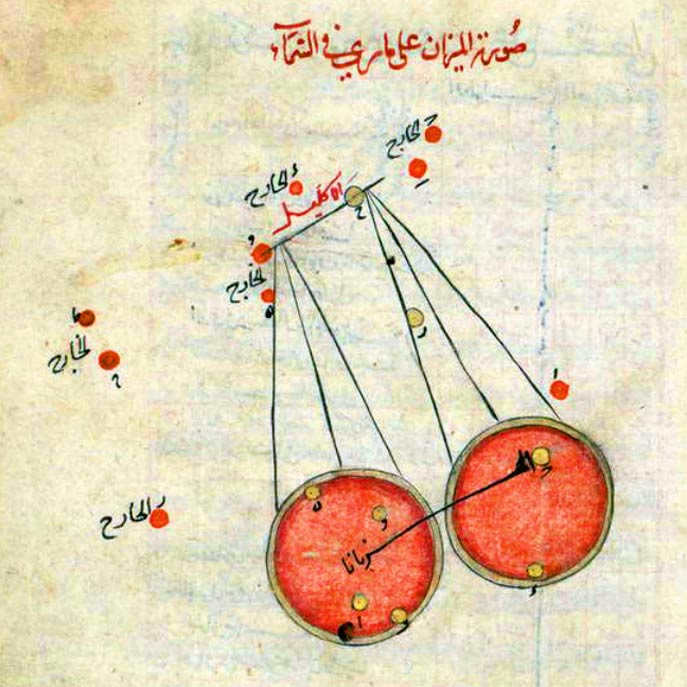
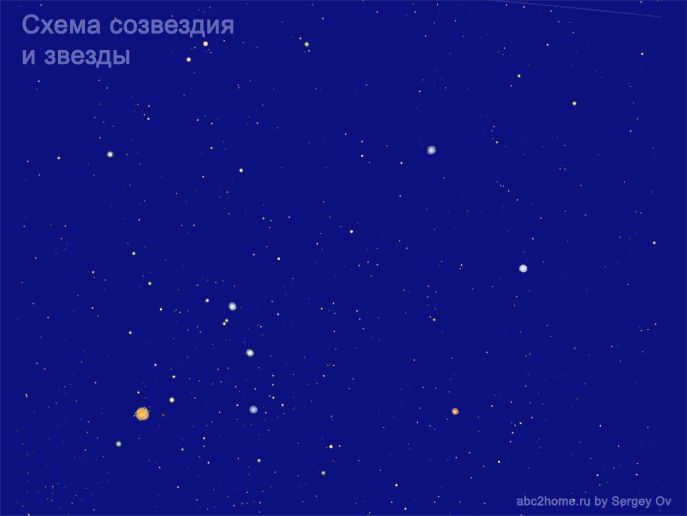
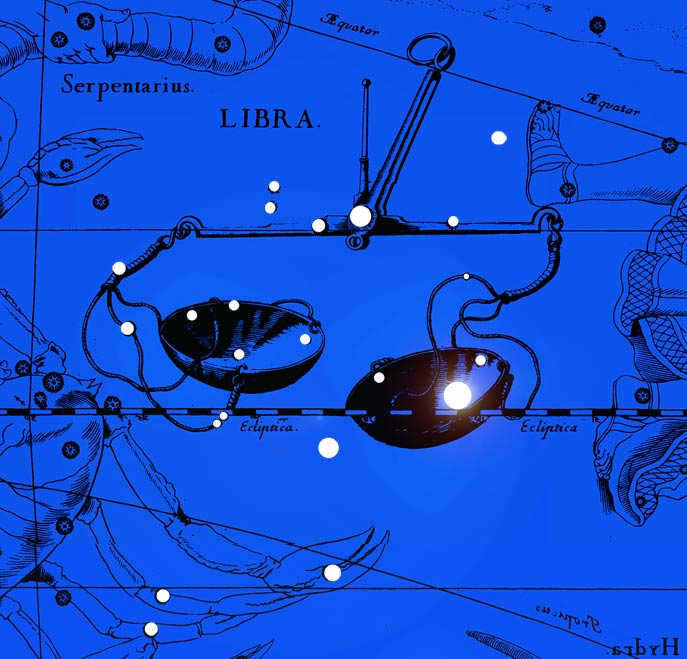
Sergey Ov (Seosnews9) presents information derived from the article: Libra: The Zodiac Sign
Notable and Prominent Stars in the Constellation of Libra
Some important points to note:
1. Stars are designated using Bayer’s signs (ε Leo), Flemsteed’s numbering (54 Leo), and Draper’s catalog (HD 94402).
2. Notable stars include those that cannot be seen without the help of optics, but have planets or other distinctive characteristics.
1. The zodiacal group comprises the constellations that give their names to the zodiac signs, except for Libra, which was actually created based on the zodiac sign by incorporating stars from the Scorpio constellation. 2. An asterism is a group of stars that forms a distinct pattern and has its own unique name. An asterism can either be a part of a constellation, such as the Big Dipper, or it can include multiple constellations, like the Spring Triangle. 3. Right Ascension and Declination are the names of coordinates in the second equatorial reference frame.
NAVIGATION AND ADVERTISING
This group of stars did not always exist, but only came into being in the 2nd century BC. Prior to that, the stars were part of the Scorpius constellation, forming the shape of claws. These claws were known as the “Claws”. However, since this area of the sky was designated as Libra in the Zodiac, it began to be referred to as Libra in the 1st century BC. Nevertheless, the brightest stars in the Libra constellation – alpha and beta, are still referred to as the South and North Pinches.
In terms of its position in the sky, Libra is the 29th largest constellation. However, there are no Messier catalog objects located here. The main attractions in this area are the prominent stars.
Because Scorpius used to include Libra, there are no specific myths associated with this constellation. Interestingly, Libra is the only zodiacal constellation that represents an object rather than a living creature.
However, there is a theory regarding the origin of the name Libra. When this constellation became independent, the Sun was located in it during the autumnal equinox. This meant that the day and night were of equal length, creating a sense of balance. Thus, the name Libra had a practical basis.
A thousand years before Christ, ancient Babylonians discovered the equinox point in the constellation of Libra and referred to this part of the sky as the “celestial balance.”
After the year 729, the equinox point shifted its position to the constellation of Virgo, where it has remained up to the present time. It will only move again to the constellation of Leo in the year 2439.
The celestial formation of Libra
The celestial formation of Libra can be found in the sky between Virgo and Scorpio. It is most easily observed during the spring season, when it rises to a sufficient height above the horizon. It can be easily located due to the presence of the bright stars from the neighboring constellations – Spica and the reddish Antares – in the southern part of the sky. The best viewing time for Libra is during the spring and summer months.

Constellation Libra’s Stellar Arrangement
Given the absence of any distinctive features other than the stars within the Libra constellation, let’s examine them in more detail.

Zuben el Genoubi serves as the Alpha star of the constellation Libra.
Beta Libra – Zuben el Shemali
Also known as the “Northern Claw,” this star is situated at the highest point of the constellation. Interestingly, despite its beta designation, it is actually brighter than the alpha star and is, in fact, the most luminous star in the constellation. It is classified as a blue-white main-sequence star with a magnitude ranging from 2.60 to 2.63, indicating that it is a variable star. With a size only 1.2 times that of the Sun and a surface temperature of 12,000 K, Zuben el Shemali emits 130 times more light than our Sun.
The variability of Zuben el Shemali is still not fully understood. It is possible that it has a nearby companion that periodically eclipses it. Interestingly, ancient astronomers such as Eratosthenes and Ptolemy observed that the brightness of this star was much greater during their time compared to its current luminosity. The reason for its dimming remains unknown.
Delta Libra – Zouben Elakribi
Delta Libra, also known as Zouben Elakribi, is an intriguing eclipsing variable star that belongs to the Algol type. It exhibits a fascinating fluctuation in its brightness, ranging from 4.91 to 5.90m. Due to this characteristic, Delta Libra can be easily observed with the naked eye or, even better, through binoculars. The star follows a regular pattern with a period of 2.327 days. Interestingly, this celestial object is not alone in the vastness of space. It is part of a double system, making it actually a triple system.
Gliese 581.
Situated above Beta Libra in the sky, Gliese 581 is a red dwarf. This star holds significant interest as it is one of the closest to our solar system, with a distance of 20.3 light-years. Its brightness measures approximately 10.56m, making it visible only through a telescope, even a compact one. What sets Gliese 581 apart is its possession of a planetary system, including a planet within the habitable zone, sparking immense curiosity.

The Gliese 581 system contains planets that are all smaller than Venus in terms of their orbit size. The central star in this system is a red dwarf, which is smaller and cooler than our Sun.
Methuselah, also known as HD 140283.
This star may seem ordinary at first glance, but it is actually a subgiant with a brightness of 7.2m, making it visible through binoculars. Take a moment to observe this star, which is an astonishing 13.3 billion years old and one of the earliest stars to form after the Big Bang. It is one of the oldest stars we know of and the oldest star visible in the northern hemisphere. Despite its age, Methuselah is relatively close to us, only 190 light-years away. It is nearing the end of its lifespan, as it has nearly exhausted its hydrogen supply.

The constellation Libra contains the star Methuselah, which is just a little younger than the universe itself.
There is another star, located in the southern constellation Southern Hydra, that is even older, with an age of 13.7 billion years. However, it can only be seen with a powerful telescope.
The presence of galaxies and star clusters within the constellation Libra.
Aside from the multitude of stars, the constellation Libra harbors other celestial entities such as galaxies and star clusters. However, these entities tend to possess a subtle luminosity, requiring the use of a sufficiently advanced amateur telescope to observe them.
NGC 5792

The constellation Libra is home to the stunning galaxy NGC 5792.
NGC 5792 is a mesmerizing spiral galaxy, featuring a distinctive junction. Positioned at an angle, it bears a striking resemblance to the renowned Andromeda galaxy M31.
At a distance of 83 million light years, NGC 5792 shines with an apparent brightness of 11.3m and a surface brightness of 13.8m. To observe this celestial wonder, it is recommended to use a telescope with an aperture of 200mm or larger.
NGC 5890
can be rephrased as
NGC 5890
is known as

The lenticular galaxy NGC 5890 can be observed in the Libra constellation.
This particular galaxy is classified as a lenticular galaxy, boasting an apparent brightness of 12.8 and a surface brightness of 13.0m. While it can be seen through larger amateur telescopes, those with smaller ones may have difficulty spotting this galaxy.
Another nearby galaxy, NGC 5885, is also worth exploring.

The constellation Libra has another spiral galaxy known as NGC 5885.
NGC 5885 has an apparent magnitude of 11.8m and a surface brightness of 14.2m, making it a challenging object to observe. It can only be seen by those who own powerful telescopes.
NGC 5897
can be rephrased as
NGC 5897
is another name for the celestial object.


